
- Beauty Products
- Clothing & Apparel
- Food Business
- Laundry Shop
- Small Stores
- Water Refilling Station
- Business Registration
- Marketing Strategy
- Human Resources
- How to Write a Milk Tea Business Plan
By Yesh Quijano
May 12, 2023
The global milk tea phenomenon has taken the beverage industry by storm, creating a vast market for innovative and delicious milk tea and bubble tea creations.
If you are an aspiring entrepreneur eager to ride this wave of opportunity, crafting a well-structured milk tea business plan is the first essential step towards achieving success.
This comprehensive guide will provide you with the necessary tools and insights to build a robust business plan, specifically tailored for the milk tea industry – even if you have no formal writing experience!

From understanding market opportunities and analyzing the industry landscape to identifying your target customers and creating a strong marketing strategy, we will cover all the vital aspects of starting a successful milk tea business.
So, buckle up and get ready to embark on an exciting journey towards turning your milk tea dreams into a thriving reality, backed by a solid plan that will set you apart from the competition.

What’s a business plan?
A business plan is a comprehensive document that outlines the objectives, strategies, and financial projections of a business venture. It serves as a roadmap, guiding entrepreneurs through the various stages of starting and growing their businesses.
By detailing the company’s mission, vision, target market, competitive advantages, and operational plan, a business plan provides a structured approach to launching and managing a successful enterprise.
What’s inside a milk tea/bubble tea business plan?
While business plans may vary depending on individual circumstances, it is essential to incorporate the following key sections to create a comprehensive and effective plan:
Executive Summary
- Opportunity
- Team and Company
Financial Plan
The executive summary provides a concise overview of your milk tea business plan, highlighting its key objectives, strategies, and financial projections.

It serves as a snapshot of your entire business plan, capturing the essence of your venture and its unique selling proposition. This section is crucial for grabbing the attention of potential investors, partners, or other stakeholders, as it offers a compelling glimpse into the potential success and profitability of your milk tea shop.
Therefore, ensure that your executive summary is well-crafted, engaging, and clearly communicates the value and vision of your enterprise.
Example Summary:
Boba Bliss is a start-up milk tea business focused on providing high-quality, customizable beverages with an emphasis on customer experience and sustainability. Our mission is to cater to the growing demand for innovative and delicious milk tea creations while promoting environmentally friendly practices. Located in a bustling commercial area, Boba Bliss aims to attract a diverse clientele, ranging from students to working professionals.
Our unique selling proposition lies in our commitment to using premium, locally-sourced ingredients, and offering a variety of healthier options such as sugar-free and vegan alternatives. We will also implement eco-conscious measures, including biodegradable packaging and a recycling program.
The marketing strategy encompasses a strong online presence, utilizing social media platforms and targeted digital advertising to engage with our audience, alongside strategic offline promotional activities. Financial projections indicate that Boba Bliss will achieve profitability within the first two years of operation, with steady growth in revenue and customer base.
Backed by an experienced management team and a well-thought-out operational plan, Boba Bliss is poised to become a leading milk tea destination, offering exceptional products and fostering a strong sense of community and environmental stewardship.
Opportunities
In this section, we delve into the reasons that make your milk tea business a viable and promising venture.
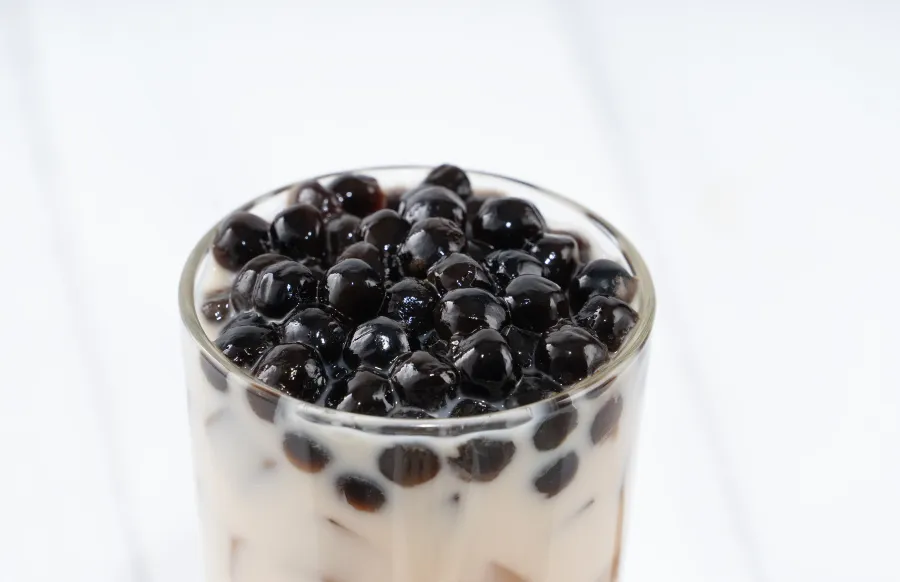
Are you the first milk tea business in your local area to introduce the milk tea experience to an untapped market? Or perhaps you possess a unique selling proposition (e.g., no sugar, vegan options) or background that equips you to excel in the milk tea industry and outshine competitors.
Milk tea, including the popular bubble tea variant, has gained massive popularity in recent years. With its delicious taste and perceived health benefits , this beverage has captured the hearts of people of all ages.
This presents a unique opportunity for entrepreneurs to tap into this growing target market and ride the wave of the milk tea trend.
Industry Analysis
Before diving into your milk tea business, it’s crucial to understand the industry landscape. Research the growth trends and key players in the market, both locally and globally.
Our recent article on business trends in the Philippines provides valuable insights into the current state of the industry and potential opportunities for new entrants.
Customer Analysis
Understanding your target market is essential for creating a successful milk tea business plan. Identify the demographics, preferences, and buying behaviors of your potential customers. Knowing your audience will help you tailor your product offerings and marketing strategies to appeal to their tastes and needs.
Competitive Analysis
A thorough competitive analysis is crucial to ensure your milk tea business stands out from the competition. Assess your competitors’ strengths and weaknesses, and identify potential gaps in the market that you can exploit. This will enable you to position your milk tea business effectively and create a unique selling proposition that sets you apart from the rest.

To turn your milk tea business plan into reality, focus on the operational aspects of your venture. This includes selecting the ideal location, sourcing high-quality ingredients, and recruiting skilled staff. An effective supply chain and efficient production processes are also critical to the success of your milk tea business.
Marketing Plan
Promoting your milk tea business is crucial to attract customers and generate sales. Develop a marketing plan that incorporates both online and offline channels, and leverage the power of social media to engage with your target audience.

We recommend reading our articles on social media marketing in the Philippines , marketing strategies in the Philippines , and online advertising in the Philippines for tips on how to maximize your marketing efforts.
Management & Operations Plan
A sound financial plan is the backbone of any successful business venture. Outline your projected expenses, revenues, and cash flow to ensure the long-term viability of your milk tea business. This will help you identify potential financial challenges and develop strategies to overcome them.

Establish a strong quality control system.
This encompasses thorough and consistent monitoring of your ingredients, production processes, and staff performance. By implementing strict quality control measures, you will ensure that your milk tea products consistently meet or exceed customer expectations, leading to enhanced customer satisfaction and brand loyalty.
This focus on quality will also contribute to a positive reputation for your business, setting you apart from competitors and paving the way for long-term success in the competitive milk tea market.
Team and Company Overview
In this section, we provide an overview of the company structure and introduce the key team members responsible for driving the success of your milk tea business. Detailing the experience, expertise, and qualifications of your management team and staff will help build credibility and demonstrate the competence of your organization.
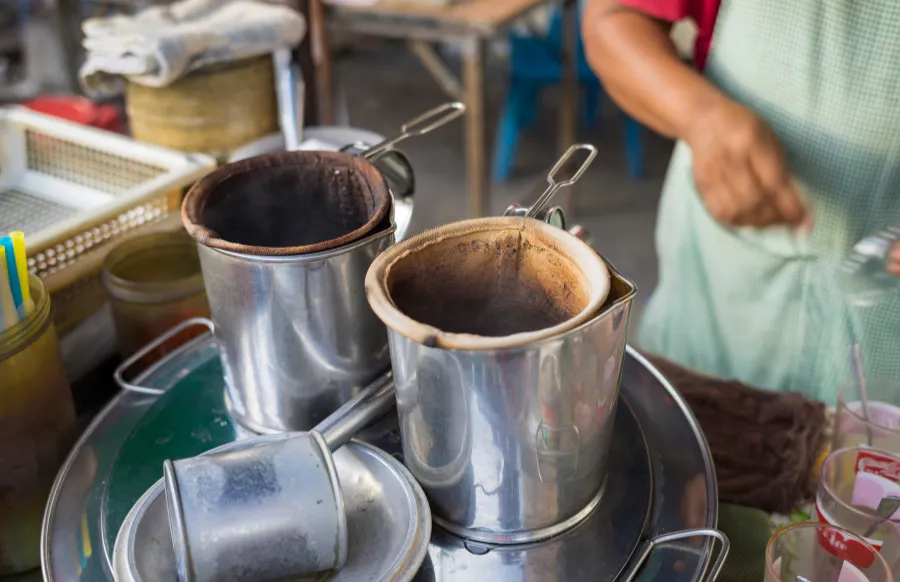
Outline the roles and responsibilities of each team member, emphasizing their unique contributions to the company’s growth and operations.
This may include experts in product development, marketing, finance, and operations, as well as skilled baristas and customer service representatives.
Additionally, provide a brief history of your company, outlining its inception, mission, and vision. Share any noteworthy milestones, achievements, or partnerships that have shaped your business thus far.
This information will help stakeholders, including potential investors and partners, understand the foundation upon which your milk tea business is built and gain confidence in its potential for success.

A comprehensive financial plan is essential for the success of your milk tea s. In this section, we provide tips and examples related to hiring, break-even scenarios, and profitability.
Funding Sources
Securing adequate funding is essential for launching and operating a successful bubble tea business. Explore various sources such as personal savings, loans from family and friends, traditional bank loans, small business grants, crowdfunding platforms, angel investors, and venture capital firms.
Each funding option has its benefits and drawbacks, so it’s crucial to determine the most suitable choice for your business. A compelling bubble tea business plan and a clear financial strategy will be instrumental in attracting the right funding partners.
By researching and leveraging these funding sources, you can secure the necessary capital to bring your bubble tea venture to life.
Your staff is an integral part of your business, and hiring the right people is crucial. Factor in the costs of recruitment, training, and employee benefits.
Budget for full-time and part-time staff, ensuring that your financial plan accounts for different salary levels, overtime pay, and any seasonal fluctuations in staffing needs.
Example: Allocate funds for hiring experienced baristas, with a budget for additional training and development to ensure they stay up-to-date with industry trends and techniques. Budget for part-time staff during peak seasons to ensure smooth operations and maintain customer satisfaction.
Break-even Scenarios
Analyze and determine the break-even point for your milk tea shop, which is the point at which your total revenues equal your total costs. This will help you identify how many units you need to sell or the revenue required to cover your costs, providing valuable insight into your pricing and sales strategies.
Example: If your fixed costs are PHP 10,000 per month and your average contribution margin per unit is PHP 2, you will need to sell 5,000 units of milk tea per month to break even.

Profitability
Forecast your profits by estimating your revenues, costs, and expenses over a specific period (usually 3-5 years). This projection will help you identify potential financial challenges and opportunities, allowing you to adjust your strategies accordingly.
Sample Computation
Based on market research, you estimate that your monthly sales will grow by 10% in the first year, reaching a 15% growth rate by the third year. With this in mind, you can calculate your expected revenues and compare them against your projected costs to determine your profitability over time.
The appendix section of your milk tea business plan serves as a repository for any supplementary documents, data, and materials that support the main content of your plan. By including these additional resources, you can provide readers with further insights and validation without cluttering the core sections.
Items that you may include in the appendix are:
- Resumes or CVs of key team members, showcasing their experience and qualifications.
- Market research data or survey results that validate your target market and customer preferences.
- Detailed financial statements , such as cash flow projections, balance sheets, and income statements.
- Licenses, permits, and certifications are required for operating your milk tea business.
- Letters of intent or agreements with suppliers, distributors, or partners.
- Marketing materials , including sample advertisements, brochures, or website mockups.
- Any other relevant documents that support your business plan and enhance its credibility.
Ensure that the appendix is well-organized and properly referenced throughout your bubble tea business plan. By providing this additional information, you can bolster your plan’s credibility and demonstrate a thorough understanding of your milk tea business and its potential for success.
Preparing a business plan for your milk tea business is worth the effort.
In conclusion, crafting a comprehensive milk tea business plan is a critical step in ensuring the success of your venture. By conducting thorough research and analysis, and developing effective execution, marketing, and financial strategies, you can position your milk tea business for long-term success.
Remember, the time and effort invested in creating a solid business plan will pay off as you navigate the exciting world of milk tea and bubble tea entrepreneurship.
About the author
Yesh Quijano
Yesh Quijano is an entrepreneur and digital marketer who's been in the game for over 11 years. He started several businesses and helped countless others reach new heights. His goal is to make digital marketing for SMEs simple, accessible, and effective. When he's not working, you can find him cuddling with his two cats.
Session expired
Please log in again. The login page will open in a new tab. After logging in you can close it and return to this page.

Burger Restaurant Business Plan [Sample Template]
By: Author Tony Martins Ajaero
Home » Business ideas » Hospitality, Travel & Tourism » Restaurant » Burger Restaurant

Are you about starting a burger restaurant? If YES, here’s a complete sample burger restaurant business plan template & feasibility report you can use for FREE to get started .
Okay, so we have considered all the requirements for starting a burger restaurant. We have analyzed and drafted a sample burger restaurant marketing plan backed up by actionable guerrilla marketing ideas for burger restaurants. So let’s proceed to the business planning section.
Why Start a Burger Restaurant Business?
Generally, burger restaurants are chain and franchised restaurants that mainly sell burgers but may also sell alcoholic and other beverages. Burger restaurant formats range from fast-food to full-service. Right from the beginning, burgers have been a staple American snack.
Burger restaurants don’t need to make anything other than really good burgers and really good fries. They are quite easy to make and don’t take much time to get ready. All you need is meat, buns, and fresh ingredients and you can make a wonderful burger in minutes, while other restaurants may need several minutes to prepare and serve their dishes.
Within the years, burger restaurants have improved. The days of simple cheeseburger with lettuce, tomato, and ketchup has long gone.
The industry is currently relishing an era of gourmet burgers and endless flavour profiles. So, just because you’re running a burger restaurant doesn’t mean that your food should be plain or simple. Most burger places today offer special sauces, gourmet toppings, and unexpected combinations.
This is indeed a business you should consider if you’re looking to venture into the food industry. With a burger business, you don’t have to worry about limiting your market to only meat lovers as there are many excellent veggie patties hitting menus everywhere that will please any veggie-lover out there.
In this modern age, it is very common to see lamb burgers, pork burgers, and even bison burgers. People who don’t eat beef can try a juicy chicken burger; if you’re pescatarian, you’ll love a salmon burger. Irrespective of your dietary restriction, there is a burger that comfortably suits your appeal. Read on as we put together a sample business plan for a burger restaurant.
A Sample Burger Restaurant Business Plan Template
1. industry overview.
The burger industry of this modern era is nothing near the industry some two decades back. Hamburger franchises have spread across the united states and have continued to explore innovative ways to turn their customers into loyal burger-fanatics.
But when it comes to a good hamburger, Americans are known to be very careful and selective. A report has it that 75% of burger-lovers rank the quality of the meat as the first or second most important attribute to their burger. Second in line were toppings, ranked either first or second place by 42% of consumers.
Although the price and affordability of the burger is considered, high-quality ingredients are still very important in producing a successful burger business. Americans to a very large extent live on burgers and are known to go for the best.
Statistics show that nearly 80% of consumers eat at fast food restaurants at least once a month, and 34% of kids in the US eat fast food every day – and that’s not including the massive number of people eating at fast casual restaurants.
Burger in the United States is now seen a food that represents patriotism and festivity. They are always present at large family gatherings, particularly Fourth of July and Memorial Day celebrations. Given the timelessness of this All-American classic, it’s no wonder that the hamburger stands as one of the few “recession-proof” foods in the United States.
But note that with America’s fight against obesity, e-coli concerns, mad cow disease, and the recent go-green campaign, the burger industry has its own share of challenges and threats. Yet statistics has it that Americans tastes are becoming more diverse and varied.
Burger has always remained top in the minds of Americans, and the reason for this longevity is most times attributed to its widespread appeal. Burgers are affordable, portable, and customizable and they can be served gourmet-style or as a rustic yet classic go-to food.
2. Executive Summary
Star Burger will offer the people of San Diego an exciting menu of burgers, sandwiches, salads, desserts and coffee beverages. We plan to make use of a system that is entirely new to the industry to provide excellent services and products in a convenient and time-efficient way.
Star Burger will provide its customers with the opportunity to drive up and place their order of well-prepared burgers and sandwiches of different flavours and toppings. We also plan to offer our clients well blended lemonade, coffees, teas, and other custom drinks to go down with our unique burger and sandwiches. We will also offer soft drinks, fresh-baked pastries and other confections.
We at Star Burger plan to reach our targeted audience by deploying Drive-through facilities and Mobile Restaurants to satisfy the various urge of the people of San Diego, California. We believe that these facilities will be designed to manage the two-sided traffic and dispense customer-designed, specially ordered burgers and sandwiches in less time than when they visit other businesses.
Star Burger hopes to provide the people of San Diego with quality products and an extensive menu of delicious items, to make sure we get our customers’ loyalty, as well as good publicity coverage and media support.
We decided to become a Drive-through cafe between the mountains, attracting several million dollars through an initial public or private offering that would allow Star Burger to open fifteen to twenty facilities per year in all metropolitan communities in the North, Midwest, and South.
Star Burger will be registered as a Limited Liability Corporation, but all membership shares for now will be owned by Sampson and Nicky Shepard, and we also plan to leverage a portion of the shares to raise capital. Our plan at Star Burger is to sell 100 membership units to family members, friends, and angel investors.
Each membership unit at Star Burger is priced at $3,087 with a minimum of five units per membership certificate, or a minimum investment of $61,740 per investor. We have plans to ensure that irrespective of the amount of share units bought, Sampson and Nicky Shepard will maintain ownership of no less than 51% of Star Burger.
3. Our Products and Services
Star Burger is a San Diego burger and assorted sandwich restaurant serving during lunch time hour as well as early evening. We would operate weekdays from 9-7 pm. Our bread is chosen for several reasons: it is unique, healthy, and versatile.
We have prepared a menu that will give each customer the choice to enjoy our burgers and never get tired. We will attract 35% new customers a year after the second year and will reach profitability by the end of year two. Below are the products we plan to offer to our customers:
- Classic Gourmet Burgers: Cheese, Lettuce, Tomato, and Onion
- BBQ Bacon Burgers: BBQ Sauce, Bacon, Cheese, and Grilled or Fried Onions
- California Burgers: All the Classic Toppings and Avocado
- Hawaiian-Inspired Burgers: Lettuce, Tomato, Pineapple, and Sautéed Mushrooms
- Savoury Veggie Burgers: Veggie Patty, Lettuce, Tomato, Grilled Onions, & Sautéed Mushrooms
- Super Spicy Burgers: Spicy Beef, Spicy Mayo, Jalapeños, and Your Choice of Cheese
- Salmon Burgers
- Sandwiches with filling options: tofu pate, falafel, hummus, baba ganouj, tabouli, turkey, ham, chicken, pesto, assorted vegetables and assorted cheeses Drinks: lemonade, coffees, blended teas, and soft drinks
4. Our Mission and Vision Statement
- Star Burger’s vision is to establish a restaurant that will provide unique and assorted services to the people of San Diego and the State of California.
- Our mission at Star Burger is to provide the finest, healthiest and best tasting burgers and sandwiches in San Diego. Star Burger will offer the finest customer service; no customer will leave dissatisfied.
Our Business Structure
We at Star Burger plan to establish a business structure that is transparent and simple, since most of our personnel will be involved in production and there will be a relatively low headcount in management. We plan to establish three functioning units within Star Burger: Production, Sales and Marketing, and General and Administrative.
Star Burger Production unit will involve our Customer Service Specialists, who will be taking care of our Drive-through and Mobile Restaurants and attending to the needs of our customers. Our Sales and Marketing will take care of the promotion and scheduling of the Mobile Restaurant, as well as the promotion of the Drive-through and the Community Contribution program.
General and Administrative will take care of the facilities, equipment, inventory, payroll, and other basic, operational processes. Due to our goal to establish a unique burger restaurant in the United States, we took our time to lay out the various roles of our employees and what we need, and they include;
Chief Executive Officer
- Chief operating officer
- Chief financial officer
- Chief information officer
- Director of marketing
- District and facilities managers
Customer Service Specialists
5. Job Roles and Responsibilities
- Increases management’s effectiveness by recruiting, selecting, orienting, training, coaching, counselling, and disciplining managers; communicating values, strategies, and objectives; assigning accountabilities; planning, monitoring, and appraising job results and developing incentives
- Creating, communicating, and implementing the organization’s vision, mission, and overall direction – i.e. leading the development and implementation of the overall organization’s strategy.
- Tasked with fixing prices and signing business deals
- Tasked with providing direction for the business
- Creates, communicates, and implements the organization’s vision, mission, and overall direction – i.e. leading the development and implementation of the overall organization’s strategy.
- Tasked with signing checks and documents on behalf of Star Burger
- Evaluates the success of the organization
Chief Operating officer
- Tasked with overseeing the smooth running of the business
- Part of the team that determines the quantity of products that are to be produced daily
- Make lists and budget for all supplies
- Oversee the entire business process
- Map out strategy that will lead to efficiency amongst workers
- Tasked with training, evaluation and assessment of the workforce
- Ensures operation of equipment by completing preventive maintenance requirements; calling for repairs.
- Ensures that the bakery meets the expected safety and health standard at all times.
Chief Financial officer
- Tasked with preparing financial reports, budgets, and financial statements for the organization
- Provides managements with financial analyses, development budgets, and accounting reports
- Tasked with financial forecasting and risks analysis
- Performs cash management, general ledger accounting, and financial reporting
- Tasked with developing and managing financial systems and policies
- Tasked with administering payrolls
- Ensures compliance with taxation legislation
- Handles all financial transactions for the organization
- Serves as internal auditor for the organization
Chief Information officer
- Provide technological guidance within an organization.
- Supervise information system and communications network.
- Develop and implement a customer service platform to serve the organization in every aspect.
- Design, establish, and maintain a network infrastructure for local and wide area connectivity and remote access.
- Participate in vendor contract negotiations for all new computer equipment and software purchased for the corporation.
- Create a cost-benefit analysis as well as supporting a detailed definition of data requirements and departmental workflows.
- Oversee Internet and computer operations.
- Takes care of the day-to-day operations of the information technology department including directing staff, who support administrative computing, networking, user services, telecommunications and other information technology functions.
- Propose hardware/software solutions to accomplish Star Burger’s business objectives.
Director of sales and marketing
- Takes care of external research and coordinate all the internal sources of information to retain the organizations’ best customers and attract new ones
- Model demographic information and analyse the volumes of transactional data generated by customer purchases
- Identifies, prioritizes, and reaches out to new partners, and business opportunities et al
- Develops, executes and evaluates new plans for increasing sales
- Represents the Star Burger in strategic meetings
- Helps increase sales and growth for Star Burger
District and facilities manager
- Monitor the P&L reports for each store and develop effective ways to fill in any gaps between actual performance and Star Burger projections
- Prioritize store performance issues to make certain that the issues most directly affecting profitability are addressed first
- Immediately address any lapses in compliance with corporate policies or local, state and federal laws
- Act as a coach to the store managers and as a resource to each store employee to help inspire success
- Ensures that all contacts with customer (e-mail, walk-In centre, SMS or phone) provides the client with a personalized customer service experience of the highest level
- Through interaction with customers on the phone, uses every opportunity to build client’s interest in the Star Burger ’s products
- Takes care of administrative duties assigned by the store manager in an effective and timely manner
- Consistently stays abreast of any new information on Star Burger, promotional campaigns etc. to make sure accurate and helpful information is supplied to customers when they make enquiries.
- Tasked with cleaning the stand at all times
- Makes sure that toiletries and supplies don’t run out of stock
- Any other duty as assigned by the CEO.
6. SWOT Analysis
Our goal at Star Burger is to create a unique restaurant that sees to the need of the people. We also decided to get our SWOT Analysis, which brings to light our strengths and threats in the industry. We at Star Burger hired a business consultant to do this analysis for us because we believe an external firm will not compromise the information and chances of Star Burger in the Industry.
We were able to note our business strengths, weakness, opportunities and also the threats that we are likely going to be exposed to in the industry and our business location. Clearly summarized below is the result of our SWOT Analysis;
Our detailed SWOT analysis has identified three keys that will be instrumental to our success at Star Burger. First and foremost, our design and implementation of strict financial controls, which will be very crucial, since the restaurant industry is quite competitive.
Secondly, we will be offering high-quality fresh and healthy food to clearly stand out from our competition in San Diego. We have already put in place effective, targeted marketing campaigns to support the opening of the restaurant.
Our weakness according to the SWOT analysis will be the time it will take the people of San Diego to know where we are and what we offer.
People go about their daily activities and most times tend not to discover the new business in town unless the business establishes a direct marketing Plan. We at Star Burger plan to start advertising even before we open up our shops, at least to make sure that our brand is known.
- Opportunities
Indeed the opportunities available to Star Burger are limitless. The food and restaurant industry is a recession-proof industry that will always keep growing because people will always want food as it helps keep us alive and sane. People may no always have the time to cook due to their schedule, and will always decide to grab a burger and a cup of lemonade or coffee on their way to work.
Our threat at Star Burger is the fact that we are competing with already established restaurants in San Diego, California, and also there are other entrepreneurs who are likely going to launch similar business within the location of our business.
But with our unique workforce and plans, we have all it takes to dominate the industry and take up enough market share.
7. MARKET ANALYSIS
- Market Trend
Burgers in this new age are indulgent and upscale with a variety of toppings, including goat cheese, truffle oil, foie gras, aolis, marmalades, sautéed spinach, havarti, candied bacon and other healthy and exotic toppings. Burger blends are all the rage extending beyond traditional chuck, to include short rib, brisket, oxtail, rib eye, flank and much more.
A report has it that 2018 is the year for everything from giant, premium burgers to sliders and mini-portions, from bold Mexican and Asian flavours to Korean, Greek, Cajun, and more. International flavours are hot and growing, and the burger is the perfect vehicle to test drive and transport many flavours.
Report also has it that restaurants are beefing up menu language to highlight protein grams and adding protein topper boosters such as pastrami, bacon and pepperoni, as well as including lettuce wrapped options to increase the protein to carb ratio.
In line with the trend for more protein, eggs are topping off many burgers for 2018. Also the largest age segment of the American population is driving burger trends now and certainly into the future with their desire for global flavours, snack-sized portions (sliders), and healthy options and toppings.
From emphasizing and bolstering “protein” on menus, consumer geared messaging is also focused on other health oriented topics and features, including grass fed, organic, natural, gluten free, naked (no bun), and more.
We at Star Burger plan to always work with customers on additional blends, which can include anything. Burger epitomizes the perfect vehicle to adapt to new trends and international flavours. As a business’s that wants to become a market leader in the United States, we will focus our energy at working with customers to develop new blends and visions
8. Our Target Market
Our plan at Star Burger is to focus on two different market audiences: Commuters and Captive Consumers. We have taken our time to strategically design our business to access both of these markets. Commuters are defined as any one or more individuals in a motorized vehicle traveling from point “A” to point “B.”
Star Burger’s greatest concentration will be on commuters heading to or from work, or those out on their lunch break. While our Captive Consumers market audience would include those who are tethered to a campus environment, or in a restricted entry environment that does not give the right to free movement.
This will include high school and college campuses, where there is limited time between classes, and corporate campuses where the same time constraints are involved like special events–such as carnivals, fairs or festivals–where there is an admission price to enter the gate, but exiting would mean another admission fee, or where refreshments are an integral part of the festivities.
Our target market at Star Burger will also be the mobile individual who has more money than time, and excellent taste in choice of food, but no time to prepare them.
Our competitive advantage
Our competitions at Star Burger exist in many forms. They include fast food that takes the form of the traditional restaurants like McDonald’s, Burger King, and Wendy’s, as well as healthier alternatives like Subway . There are also three different delis located in San Diego that serve deli style sandwiches. These delis serve very basic, standard deli fare; generally sliced deli meats.
But we at Star Burger know that with the unique offerings we bring, we can dominate the market especially with a business that can provide a substantial value proposition where a customer does not have to find a parking place, exit the vehicle, stand in line to order, wait for the burger to be produced, pay a premium price for average product, find a place to sit, clean up the previous customer’s mess, then enjoy their lemonade or coffee… That’s if they have much time to spend.
Star Burger business concept is to establish a restaurant that gives a customer the opportunity to drive up, place the order, receive a high quality product at a competitive price, and drive away, without spending much time and energy. We at Star Burger plan to provide an important community value for patronizing our business.
For every purchase a customer makes from us, we plan to donate up to 6% of the sale to the local charity selected by the customer.
9. SALES AND MARKETING STRATEGY
- Sources of Income
Star Burger is a new restaurant with a unique plan to achieve success and become an industry leader. That is why we will be providing our products in the most convenient and efficient way available–either at one of our two-sided Drive-through shops, or at one of our Mobile Restaurant.
This will give us an advantage over our competitors because customers won’t need to find a parking place, wait in a long line, jockey for a seat, and clean up the mess left by a previous patron. Our goal at Star Burger is to provide enough income to be able to run our business and still move on with our charity aspect. We plan to generate income by offering the following products to the people of San Diego:
10. Sales Forecast
Star Burger will open its doors for business by having two Drive-through locations in operation. We plan to open our first location in the second month of this plan and be fully operational beginning on the 1st day of November, and our second Drive-through will open six months later.
We will also add two more Drive-through locations in our second year and, and an additional seven Drive-through facilities in our third year. We at Star Burger plan to deploy one mobile unit in the fourth quarter of the first fiscal year. Deploy a second and a third mobile unit within our second fiscal year.
Using our detailed research and analysis, we expect to boost revenue from the commerce portion of our website, where it will sell Star Burger t-shirts, sweatshirts, insulated lemonade mugs, pre-packaged coffee beans, and other premium items. Although we are not expecting this to be a significant profit centre immediately, but it is a major part of the marketing plan.
We at Star Burger estimate that our total first year sales should reach $399,678. Our second year will see sales increase to $1,085,430. The third year, with the addition of such a significant number of outlets, we will see sales increase to $3,765,215.
- Marketing Strategy and Sales Strategy
With so many burger franchises and independent restaurants already open, marketing is one of the most important aspects of opening a burger restaurant. We at Star Burger understand this, which is why we will be placing our Drive-through stands in business locations of very high visibility and great ease of access.
Our Restaurants and stands will be located on high traffic commuter routes and close to shopping facilities so as to attract customers going to or from work, or while they are out for lunch, or on a shopping expedition. Our Drive-through will be very simple, astounding, and eye-catching.
We also plan to implement a low cost advertising/promotion campaign which could involve drive-time radio, but not much more. Star Burger will also establish good business relationships with schools, charities and corporations to provide significant free publicity because of our community support program.
We believe that if we give out charitable contributions to these institutions, they will get the word out to their students/faculty/employees/partners about Star Burger.
We also plan to leverage the use of word of mouth advertising method, which is the greatest advertising program any business organisation can use. The media in San Diego will be more than willing to promote the charitable parts of Star Burger and give us the opportunity for more exposure each moment Star Burger contributes to charity.
The internet is a powerful marketing tool we at Star Burger cannot afford to overlook. We plan to create an optimized website to capture local searches and also establish a strong social media presence to easily boost sales. When we first open, we plan to create a local press release, run grand opening specials to draw in potential customers, and even invite local food bloggers to come try a free meal in exchange for a review.
11. Publicity and Advertising Strategy
Our plan at Star Burger is to gather enough brand awareness to leverage the product line into other regions and gain inquiries from potential inventors. To achieve this goal, we plan to do the following;
- Star Burger will spend $1,200 per month on public relations services for the next year. We intended to build awareness and carry out product information insertions, reviews, etc. We believe that a school fundraising program or our other charity programs will generate a fair amount of publicity on its own and will, perhaps, minimize–or even eliminate–the need for a publicist.
- Star Burger will also spend $800 per month concentrating on drive time Radio advertising. We plan to experiment with different stations, keeping careful track of results. As with the school fundraising program, we expect the stand and signage to be a substantial portion of our advertising.
- List our business on yellow pages ads (local directories)
- Leverage on the internet to promote our business
- Engage direct marketing approach
- Encourage word of mouth marketing from loyal and satisfied clients
12. Our Pricing Strategy
We haven’t gone back on our promise to leave no stone unturned in our quest to achieve our business goal. We at Star Burger have put plans in place to boost our income, which may include posting specials on high-profit items at the drive-up window.
We also plan to give out free burger coupons to those who have purchased a certain number of burgers or something similar.
Our management have been able to develop window sales techniques such as our sellers asking if the customer would like a new flavour or toppings with any drink of their choice. We believe that our pricing will be comparable to the competition in the market, but with the value-added feature of immediate, drive-through service and convenience.
- Payment Options
Our payment options at Star Burger will be all inclusive and acceptable because we understand that different people prefer different payment options. Here are the payment options that we will make available to our clients;
- Payment by cash
- Payment via Point of Sale (POS) Machine
- Payment via online bank transfer (online payment portal)
- Payment via Mobile money
We have also chosen banking platforms that will help us achieve our plans with little or no issues. Our bank account numbers will be made available on our website and promotional materials to clients who may want to deposit cash or make online transfer for our service.
13. Startup Expenditure (Budget)
First and foremost, many factors in our modern America will decide the amount we will need to successfully launch Star Burger. These factors may include our location, the size of the business we want to start i.e. the number of outlets/stands et al, and of course the state of the economy as at when we intend starting the business.
We at Star Burger have conducted an extensive research and have come up with how we intend to spend our startup capital, and they include;
- The Fee for registering the business in the United States – $750
- The budget for legal fees, insurance, permits and license – $30, 000
- The amount needed to build a two standard shop and renovation of the facility inclusive – $60,000
- The Cost for the purchase of kitchen / production equipment and gadgets (industrial ovens, fridges, smoke detector, TVs, microwave oven, mugs, Foils, Sound System, tables and chairs et al) – $25,000
- The Cost for supply of bread and other inventories for a month – $120,000
- The Cost of Launching a Website – $600
- The cost opening party – $5,000
- Additional Expenditure (Business cards, Signage, Adverts and Promotions et al) – $100,000
Going by the report from our research and feasibility studies, we will need an average of $350,000 to start Star Burger.
- Generating Startup Capital for Star Burger
Star Burger will be established as a Limited Liability Company with Sampson and Nicky Shepard as its owners. This couple has a combined 25 years’ experience in the food and burger industry, and they hope to build a successful business. We hope to raise our startup fund through the following ways;
- Generate part of the start – up capital from personal savings and sell of stocks
- Source for soft loans from family members and friends
- Generate fund from Angel Investors
Note : We have been able to raise $200,000 from the personal savings of our founders and we are almost at the verge of completing the money needed as capital from a reliable Angel investor with an eye for startup businesses.
14. Sustainability and Expansion Strategy
We at Star Burger believe that as time and seasons change, we will be offering products that will enhance sales and satisfy our customers’ desires. We also plan that during summer months, we will subsidize frozen drinks like lemonade, as well as soft drinks, and other cold beverages.
We at Star Burger have taken our time to research our local regulatory agencies and what licenses we need. These requirements we believe will vary by location, but we have a strong relationship through Mr. Sampson Shepard with the state chamber of commerce and health department and we plan to stay on the right side of the law.
We have put plans in place to get our business license, which legally allows us to make sales and collect sales tax, and a food handling certification, which we have acquired. We have also obtained the needed permits for construction and we are also expecting an inspection from the health department.
We at Star Burger also understand the importance of insurance for our business. We have contracted an insurance lawyer to help us get property insurance, which will help protect our building and surrounding property, providing coverage for fire, hail, or accidental damage.
We expect this type of policy to cover expensive commercial kitchen equipment , so we will be able to replace pieces damaged under covered circumstances.
We also plan to obtain liability insurance, as it covers legal fees and any damages that may be awarded as a result of a legal action against our business from any accidents or injuries. We will also offer worker’s compensation insurance to provide peace of mind to both the management and our employees, as it helps cover medical bills that may arise from employee injuries.
Our Drive-through stands will be manufactured by Lintel Construction. Our Mobile Restaurant and equipment will be supplied by Guarantee Savage. Star Burger computer equipment and Internet connectivity will be provided by Nicklaus Communications.
Checklist/Milestone
- Business Name Availability Check: Completed
- Business Incorporation: Completed
- Opening of Corporate Bank Accounts various banks in the United States: Completed
- Opening Online Payment Platforms: Completed
- Application and Obtaining Tax Payer’s ID: In Progress
- Application for business license and permit: Completed
- Purchase of Insurance for the Business: Completed
- Conducting Feasibility Studies: Completed
- Leasing, renovating and equipping our facility: Completed
- Generating part of the startup capital from the founder: Completed
- Applications for Loan from our Bankers: In Progress
- Writing of Business Plan: Completed
- Drafting of Employee’s Handbook: Completed
- Drafting of Contract Documents: In Progress
- Design of The Company’s Logo: Completed
- Graphic Designs and Printing of Packaging and Promotional Materials: Completed
- Recruitment of employees: In Progress
- Purchase of the Needed software applications, furniture, office equipment, electronic appliances and facility facelift: In progress
Related Posts:
- Vegetarian Restaurant Business Plan [Sample Template]
- Snack Bar Business Plan [Sample Template]
- Korean Restaurant Business Plan [Sample Template]
- Fine Dining Restaurant Business Plan [Sample Template]
- How Much Does It Cost to Start a Burger Restaurant?
How To Start A Milk Tea Business: A Step-by-step Guide For Entrepreneurs
What To Know
- If you’re passionate about entrepreneurship and eager to tap into this lucrative market, this comprehensive guide will equip you with the essential knowledge and strategies to launch a successful milk tea business.
- Experiment with various toppings and add-ins, such as tapioca pearls, pudding, and fruit jellies, to enhance the visual appeal and taste of your milk tea.
- The ambiance of your milk tea shop plays a significant role in attracting and retaining customers.
In recent years, the milk tea industry has experienced a meteoric rise, captivating taste buds worldwide . This delectable beverage, with its harmonious blend of tea, milk, and an array of enticing flavors, has become a symbol of refreshment and indulgence. If you’re passionate about entrepreneurship and eager to tap into this lucrative market, this comprehensive guide will equip you with the essential knowledge and strategies to launch a successful milk tea business.
1. Unraveling the Milk Tea Market: Understanding the Landscape
Before embarking on your milk tea venture , it’s crucial to gain a thorough understanding of the market landscape . Conduct extensive research to grasp the current trends , consumer preferences, and competitive dynamics. Assess the demand for milk tea in your target area, identifying potential gaps or underserved niches. Analyze your competitors, examining their strengths, weaknesses, and unique selling points. This market analysis will provide invaluable insights for tailoring your business strategy and positioning your brand effectively.
2. Crafting Your Milk Tea Symphony: Selecting the Right Flavors
The heart of any milk tea business lies in the flavors it offers. Curate a diverse and enticing menu that caters to a wide range of palates. Experiment with classic flavors like original milk tea, taro, and mango, while also introducing innovative and seasonal creations to keep your customers intrigued. Ensure that your flavors are well-balanced, with the perfect harmony of sweetness, creaminess, and tea aroma . Consider offering customizable options, allowing customers to tailor their drinks to their preferences.
3. Sourcing Quality Ingredients: Ensuring an Unforgettable Experience
The quality of your ingredients directly impacts the taste and overall experience of your milk tea . Partner with reliable suppliers who can provide fresh , high-quality tea leaves, milk, and other ingredients. Opt for premium tea blends that deliver a rich, flavorful brew. Select fresh milk or milk alternatives that complement the tea’s characteristics. Experiment with various toppings and add-ins, such as tapioca pearls, pudding, and fruit jellies, to enhance the visual appeal and taste of your milk tea.
4. Designing an Enticing Ambiance: Creating a Memorable Space
The ambiance of your milk tea shop plays a significant role in attracting and retaining customers. Create a welcoming and inviting space that reflects your brand’s personality. Consider the layout, seating arrangements , and décor, ensuring they align with your target audience’s preferences. Incorporate elements that enhance the overall experience, such as comfortable seating, ambient lighting, and soothing music. Maintain a clean and hygienic environment to foster a positive and memorable customer experience.
5. Marketing Mastery: Spreading the Word About Your Milk Tea Haven
In today’s digital age, a strong marketing strategy is essential for the success of any business. Utilize various marketing channels to reach your target audience and generate awareness for your milk tea shop. Create a visually appealing website that showcases your menu, prices, and unique selling points. Leverage social media platforms to engage with potential customers , share enticing content, and run targeted advertising campaigns. Partner with local influencers or bloggers to promote your brand and reach a wider audience.
6. Operational Excellence: Ensuring Smooth and Efficient Operations
Efficient operations are the backbone of a successful milk tea business. Implement a robust system for managing orders, inventory, and staff scheduling. Invest in high-quality equipment, such as tea brewers , blenders, and refrigerators, to ensure consistent product quality and speedy service. Train your staff thoroughly on product preparation, customer service, and hygiene practices . Establish clear policies and procedures to maintain operational efficiency and ensure a positive customer experience.
7. Adapting to Changing Tides: Navigating Challenges and Embracing Opportunities
The business world is constantly evolving, presenting both challenges and opportunities. Stay informed about industry trends, consumer preferences, and technological advancements. Be prepared to adapt your menu, marketing strategies, and operational procedures to meet changing market demands. Embrace innovative technologies that can enhance customer experience, such as online ordering, loyalty programs, and delivery services. Address challenges proactively, seeking solutions that align with your business goals and values.
Beyond Conclusion: Your Milk Tea Journey Awaits
Starting a milk tea business is an exciting and rewarding endeavor that requires careful planning, passion, and dedication. By following the steps outlined in this comprehensive guide, you can lay the foundation for a successful and thriving venture. Remember to continuously innovate, adapt to changing market dynamics, and maintain a customer-centric approach. With hard work, determination, and a love for milk tea, you can create a business that not only satisfies taste buds but also leaves a lasting impression on your customers.
Questions You May Have
1. What are the key factors to consider when choosing a location for my milk tea shop?
- Accessibility: Ensure your shop is easily accessible to your target audience, with ample parking or public transportation options.
- Visibility: Choose a location with high foot traffic and visibility, such as a busy shopping center or near a university.
- Competition: Analyze the competitive landscape in the area, ensuring there’s a demand for milk tea and that you can stand out from competitors.
2. How can I create a unique and memorable brand identity for my milk tea shop?
- Define your brand values and personality: Identify the core values and unique selling points that differentiate your brand from competitors.
- Develop a strong brand identity: Create a visually appealing logo, design a cohesive color palette, and choose a brand name that resonates with your target audience.
- Tell your brand story: Share the story behind your brand, highlighting the passion and dedication that goes into crafting your milk tea.
3. What are some effective marketing strategies for promoting my milk tea shop?
- Social media marketing: Utilize social media platforms to engage with potential customers, share enticing content, and run targeted advertising campaigns.
- Influencer marketing: Partner with local influencers or bloggers to promote your brand and reach a wider audience.
- Community involvement: Sponsor local events or participate in community initiatives to build brand awareness and foster positive relationships.
Popular Posts:
Leave a Reply / Feedback Cancel reply
Your email address will not be published. Required fields are marked *
Save my name, email, and website in this browser for the next time I comment.
Find Out More
Indulge in boba bliss: learn how to cook milk tea like a pro, how to make milk tea in your kitchen: a step-by-step guide for the perfect cup, 1) is zagu milk tea the secret to a longer life here’s what science says., is milk tea a drink the surprising truth you never knew, milktea brown hair: the latest hair trend and how to get it without leaving your home, the secret behind: can you keep milk tea overnight without compromising its taste.

Building Bridges, Cultivating Success
Everything You’ll Need to Start Your Own Milk Tea Business
- October 24, 2020
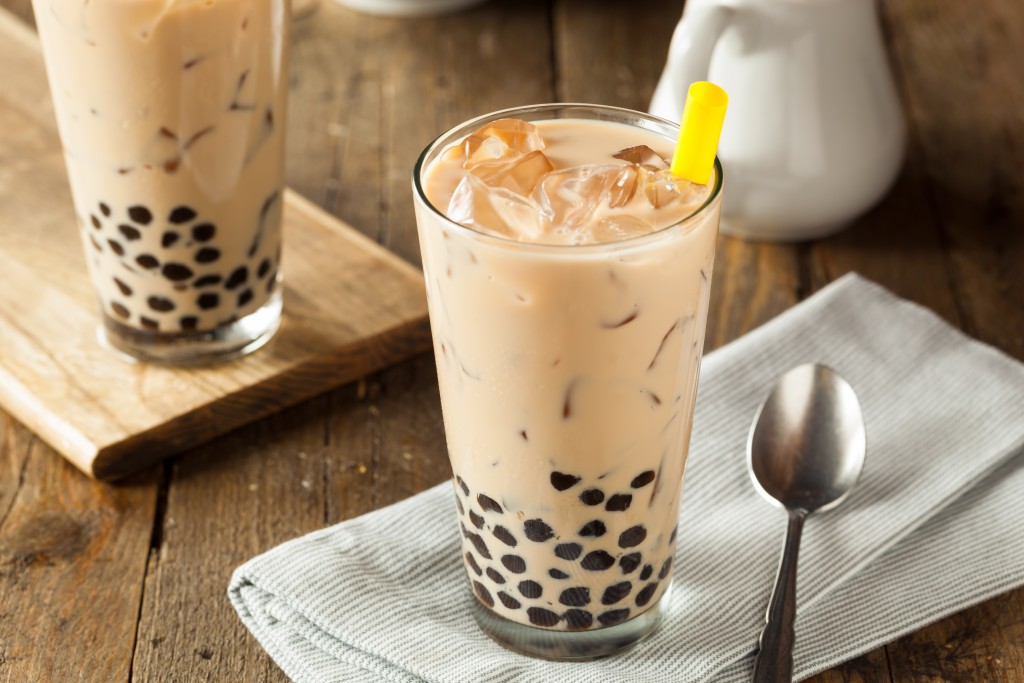
For the past few years, milk tea –– also known as boba tea or bubble tea –– has become a worldwide craze. There are plenty of milk tea shops on the market. It’s amazing how all of them stay alive even with all the competition. The great thing about milk tea is that you can customize it and create hundreds of different flavors. It’s also not that hard to make. If you’re looking to start your own business, maybe you should hop on the milk tea craze too! Here’s how you can start:
Do some market research.
It’s important to market research before starting up any business. You can’t just start a business without doing some research first. Market research allows you to understand your target market. You get an in-depth idea of their various wants and needs and their consumer problems. Conducting market research also allows you to understand your competition. This will help you identify what you can do to set yourself apart from others.
When conducting your market research, you have to define your goals and objectives first. What do you want to know about your market? Something as simple as knowing how much your target market is willing to pay for your product, or what kind of design and packaging they would prefer? You could even ask what flavors they would like. You could also use this research to pinpoint your competition’s weaknesses. Conduct a survey and ask people what they think most milk tea shops lack and see if you can provide that service or product –– things like that.
Pick a niche
After you’ve done your market research, you should have enough data to determine your target market’s expectations and how you can set yourself apart from other businesses. Maybe you want your business to have a certain theme. Think of something that will make your business stand out. Maybe it’s the aesthetics, the number of flavors on your menu, the customization of the drinks, the size of your products, or the ambiance of your store.
Handle your finances
A key factor in starting your own business is having enough capital to do it in the first place. Capital is the amount of money that will help you start your business. This includes the budget for your store location, equipment, employees, and marketing. Do you have enough capital? If not, maybe you should look into what loans you can get for your business. Usually, when it comes to getting a loan, you would have to prepare a business plan to present to the lenders or investors. Having a good business plan and cash flow analysis will make lenders feel safer lending their money.
Look for a location
The next thing you need to do is find a store location. That is unless you decide to start your business from home. Starting a business at home is great for various reasons. First of all, you save money because you won’t have to spend leasing a commercial space. You also get a wider reach of customers when you sell online. It would also be much safer to sell from home while the pandemic is ongoing.
Fix all your permits and licenses
You must get your business registered. Starting a food and drink business also requires that you get a permit from the Health Department. These are the different permits and licenses you will need:
- Business license
- Personnel permits or licenses
- Tax registration
- Trade name registration
- Employer registration
- Business name and logo

Figure out the equipment and supplies you will need
For the equipment, the most common equipment and supplies used in a milk tea shop are:
- Tea Brewing Machine
- Stove or Table Burner
- Cooking Pot
- Tapioca Container
- Measuring Scoop
- Cup Sealing Machine
- Shaking Cups
- Water Dispenser
- Refrigerator
- Cash Register
- Cups and Lids
- Oversized Straws
If you set up your business from home, you wouldn’t have to spend so much on the equipment because most of this can be found at home, such as the brewing machine, stove, cooking pots, strainers, containers, scoopers, dispensers, refrigerators, and other utensils. The only things you would actually have to spend on are the packaging equipment and supplies.
A great eco-friendly packaging design for milk tea entails using glass bottles instead of plastic cups. Instead of buying a cup sealing machine and using up so much plastic, you could opt to use glass bottles and a liquid filling machine instead. Investing in liquid filling equipment can allow you to fill the bottles faster and accurately; no struggle, no stress, and no waste of milk tea. What’s great is that people could reuse the bottles for personal use, instead of throwing them away.
Market your business
After you’ve set up all the legal stuff, the equipment, and supplies, you can now market your business. Using social media and digital marketing is the easiest, most cost-effective way to promote your business. If you’re clueless about how to do your own marketing, there are plenty of guides on the internet . You could even hire professional digital marketing services online.
Now that you’ve got an idea of starting your milk tea business, all you have to do is make it happen!
About the Author
Rebecca nichols, latest articles.

Easy Steps to Keep Your Yard Ant Free

10 Family Priorities To Take Care Of

How to Choose the Right Massage at New Hope

The Benefits of Living in the Best Community Estates

How to Find Land Property for Sale

feature article:
How to start a milk tea business.

How to start a milk tea business? If you have not tried or know what milk tea is, you must have lived in the middle ages. This perfect combination of tea and milk has captured the hearts of millions, especially in the 21st century. The best part of the beverage of the century is that it Is customizable, from the sinkers to the sugar content!
Perfect for any day, the demand for milk tea continues to increase so much that suppliers are putting up to the challenge! With various milk tea shops in the Philippines , it is essential to stay in the zone, being highly competitive and in the trend! Here are some points to consider when starting your own milk tea business:
1. Milk Tea Business Plan and Market Strategy. The milk tea market is very flexible. The milk tea business name (milk tea business name) must be chosen wisely and strategically to make it a more catchy and easy brand to remember. The menu can range from original milk tea flavors to in-house specialty with different flavors, sinkers, and other add-ons! It is essential to know where your business will go and set an image exactly! Consider searching for recipes that would significantly impact the milk tea world, targeting your ideal audience. Consider a market strategy for start-ups, such as promos to gain an audience and consider the prices of products. Throughout the process, it is vital to have a goal and stick to it. Never forget capital and budgeting, making sure every part of the process is within the scope of your budget. This planning stage is crucial in identifying your business’s essential details. Milk tea recipes for business are also a crucial part of this planning as they must also fit with your market plan; free video content tutorial on how to properly make milk tea is also available on some websites.
2. Audience, Location, Advertisement. Whether you want to have a niche (target market of milk tea) or explore the general menu of milk tea production, you must consider your audience and envision if you were the customer. With the current situation, a pop-up store, online store, or in-store location are options for where you can put up your business. The access to the location should be practical and easily navigated by your target customers. Furthermore, to get your audience’s attention, consider how your product can reach them through advertisements. A friendly competitor milk tea shop nearby is common; your business must stand out in the competition!

3. Reliable Suppliers. The secret to an unforgettable milk tea is within its ingredients! This is what makes your customers keep coming back! Your business’s quality and image highly depend on your investment in ingredients and equipment. This part is very decisive. Aside from the time and money you put into it, this predicts the future of your business; thus, consider suppliers as your co-workers, only giving quality ingredients and equipment. There are several milk tea ingredients and equipment that can be checked here . If you are looking for a milk tea business plan example, take this opportunity to talk to reliable suppliers as they have first-hand knowledge of how successful milk tea brands were able to establish their business.
4. Business Permits and Licenses. Whether starting small or starting big, it is critical to comply with the requirements set by the trade industry. This includes business license, tax registration, business name, logo, etc. Complying increases the market value and avoids penalty fees. Remember to register your Milk tea business name in the Intellectual Property Office to protect your brand marketing effort from those who might want to grab your effort of growing your brand.
5. Start Your Milk Tea Business. Get everything going! Make and market your milk tea business to your audience. Let the word spread by mouth or through online platforms, word of mouth, and event sponsorship. Be open to feedback, as it is a work in progress. Trust the process, and you are on a roll!
share article:

features category
• search blog articles •, • help center •, • get social •, • latest posts •.

The Complete Guide to Matcha Powder Drinks: A Green Elixir for Health and Wellness

Soft Serve Dreams: Choosing the Perfect Ice Cream Machine for Your Start-Up Venture

Types of Coffee Beans: A Quick Guide

Base Powders for Food and Beverages: Powdered Bases

Soft Serve Ice Cream Machine: How Does It Work

Coffee Beans Supplier in the Philippines: What to Look For

Materials Needed for Milk Tea Business: General Checklist
• other feature articles •.

The Best Locations to Open a Soft-Serve Ice Cream Business

10 Things You Need to Start a Cafe Business

Finding the Best Locations for Starting Your Own Coffee Shop Business

Benefits of Using Premix Powders for Beverages

The Ultimate Glossary of Milk Tea and Bubble Tea Terms

10 Foods that Pair with Milk Tea Perfectly

Differences of Ice Cream, Gelato, Soft Serve, Sorbet & more

The Bestselling Milk Tea Flavors

Milk Tea Supplier | Finding a Milk Tea Ingredients Supplier

From Assam to Matcha: 10 Teas for Making Milk Tea and Bubble Tea

7 Things to Look for in a Coffee Machine for your Cafe
Need a business plan? Call now:
Talk to our experts:
- Business Plan for Investors
- Bank/SBA Business Plan
- Operational/Strategic Planning
- L1 Visa Business Plan
- E1 Treaty Trader Visa Business Plan
- E2 Treaty Investor Visa Business Plan
- EB1 Business Plan
- EB2 Visa Business Plan
- EB5 Business Plan
- Innovator Founder Visa Business Plan
- UK Start-Up Visa Business Plan
- UK Expansion Worker Visa Business Plan
- Manitoba MPNP Visa Business Plan
- Start-Up Visa Business Plan
- Nova Scotia NSNP Visa Business Plan
- British Columbia BC PNP Visa Business Plan
- Self-Employed Visa Business Plan
- OINP Entrepreneur Stream Business Plan
- LMIA Owner Operator Business Plan
- ICT Work Permit Business Plan
- LMIA Mobility Program – C11 Entrepreneur Business Plan
- USMCA (ex-NAFTA) Business Plan
- Franchise Business Planning
- Landlord Business Plan
- Nonprofit Start-Up Business Plan
- USDA Business Plan
- Cannabis business plan
- eCommerce business plan
- Online Boutique Business Plan
- Mobile Application Business Plan
- Daycare business plan
- Restaurant business plan
- Food Delivery Business Plan
- Real Estate Business Plan
- Business Continuity Plan
- Buy Side Due Diligence Services
- ICO whitepaper
- ICO consulting services
- Confidential Information Memorandum
- Private Placement Memorandum
- Feasibility study
- Fractional CFO
- How it works
- Business Plan Examples
Bubble Tea Shop Business Plan Template
Published Mar.21, 2018
Updated Apr.19, 2024
By: Brandi Marcene
Average rating 4.3 / 5. Vote count: 19
No votes so far! Be the first to rate this post.
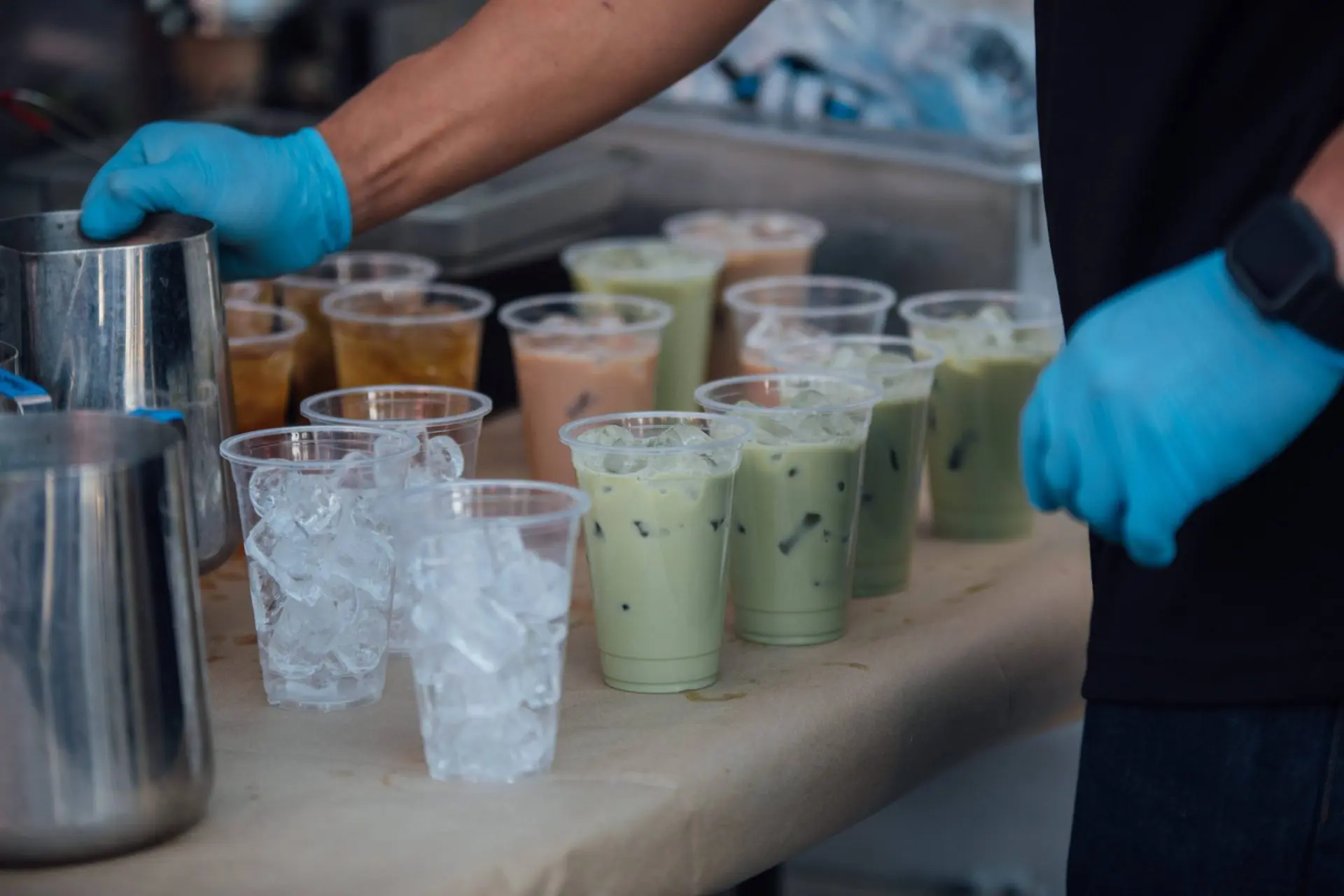
Table of Content
Do you want to start bubble tea shop business?
Starting a bubble tea shop business is very easy and extremely profitable as well. If you don’t know how to open a bubble tea shop, just go through this milk tea business plan template. It will guide you through everything which you need to know for starting this venture. The first thing you should do is to develop a comprehensive plan for your tea room business model . The business plan will not only help you in startup but it will also help you in taking important decisions for your company over the next years. In case you don’t know how to write a good milk tea business plan, we are providing a detailed milk tea business plan template of a bubble tea shop startup ‘Sam’s Stop’ to help you avoid the trouble of making a plan yourself.
Executive Summary
2.1 the business.
Sam’s Stop will be a licensed and ensured tea shop located in Downtown Manhattan. We will be strategically located in the most suitable place for opening a bubble tea shop business plan.
2.2 Management
The business will be solely owned and operated by Sam Kin who is a graduate from Harvard University and is known for his sharp business acumen and exceptional management skills. Sam will hire a small team comprising of chefs, waiters, assistants and cleaners for operating and managing the shop.
2.3 Customers
Our customers will primarily be the residential community living near our shop. We will offer high-quality and healthy tea latte, milk tea, fruit flavored tea, brown sugar milk, macchiato and slush to our esteemed customers.
2.4 Target of the Company
Our primary target is to become the best tea shop in the New York City within next 3 years of our launch. Our secondary target is to achieve the net profit margin of $10k/month by the end of the first year, $15k/month by the second year, and $25k/month by the third year.
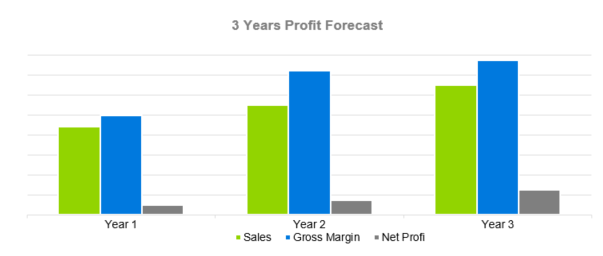
Company Summary
3.1 company owner.
Sam is a business graduate of Harvard University. After completing his Bachelor’s, he worked with a couple of fast food restaurants at executive positions. He is known for his sharp business acumen and exceptional management skills.
3.2 Why the Business is being started
The main motive behind Sam starting a bubble tea business plan is his intense passion for tea room business model . Sam has exceptional business skills and this venture is just his first step into the business world. Within next three years he plans to open five more bubble tea spots in different cities, and after that, he will move towards business plans for restaurants . So, this venture is where Sam will enter the corporate sector.
3.3 How the Business will be started
Sams’s Stop will be launched in a 200-square-feet shop located in the main commercial market of Downtown Manhattan. The shop was previously used as a grocery store, so a lot of work needs to be done for turning it into a tea shop. The company’s financial experts have forecasted following costs for the start-up:
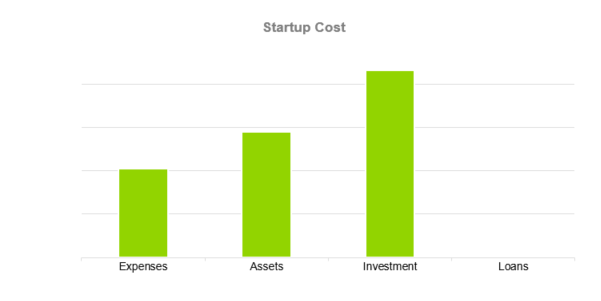
Services for customers
It is wiser to plan your services or menu before you think about how to start a milk tea business plan template. You can only plan subsequent things after you know what you will be providing to your customers. Sam’s Stop will offer following products to its customers:
- Milk Tea: Bubble Milk Tea, Brown Sugar Milk Tea, Almond Milk Tea, Hazelnut Milk Tea
- Tea Latte: Black Rose Latte, Oolong Latte Float, Matcha Latte, Tie Guan Yin Latte
- Fruit Flavored Tea: Peach Green Tea, Mango Green Tea, Honey Green Tea, Fresh Lemon Green Tea
- Brown Sugar Milk: Black & Yellow Milk, Black Babo Milk, Red & Yellow Milk
- Macchiato: Rose Tea Macchiato, Jasmine Green Tea Macchiato, Milk Tea Macchiato
- Slush/Milk Shake: Oreo Milk Shake, Mango Slush, Passion Fruit Slush, Ice Cream Shake
Marketing Analysis of bubble tea shop business
The most important component of an effective milk tea business plan is its accurate marketing analysis that’s why Sam acquired the services of marketing experts to help him through this phase. It is only after this stage that a good bubble tea business plan template could have been developed. After identifying the local market trends in Manhattan, the marketing experts and analysts also helped him in developing the bubble tea marketing plan.
5.1 Market Trends
As for a general trend, the market demand for bubble tea businesses is on the rise. Bubble tea is one of the most popular drinks with Americans. The biggest reason behind the popularity of this bubble tea shop business plan template is that people are becoming more health conscious day by day.
As a result, people have started avoiding carbonated drinks and have leaned towards healthy alternatives such as smoothies, slushes, milk and fresh fruit juices. That’s why the number of bubble tea shops has been increasing during the last few years. In short, this industry has a lot of potential and even a small bubble tea shop can yield immense profit provided that you successfully plan it and target your customers.

5.2 Marketing Segmentation
Our marketing experts have identified following type of target audience which can become the potential customers of our tea shop.
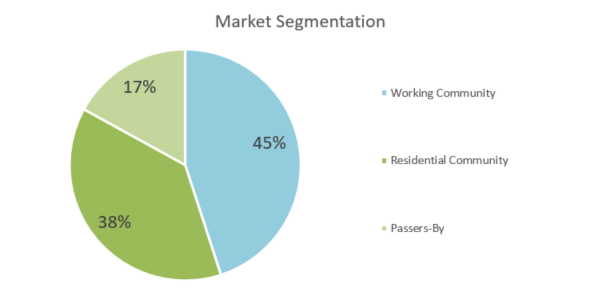
The detailed marketing segmentation comprising of the company’s target audience is as follows:
Operational and Strategic Planning
5.2.1 working community:.
The first category includes the workers and employees who work in the businesses or offices located in the vicinity of your milk tea business plan template. This group leads a strenuous life, burdened with plenty of work and thousands of matters to think upon. It has been observed that this group often takes soft drinks, especially coffee and bubble tea to take a break from their hectic routine. Our tea shop will be the perfect place for them to rest while on their way home.
5.2.2 Residential Community:
The second group of our target customers will be the community residing in the vicinity of our restaurant. Bubble tea is one of the favorite drinks of American teens so we hope to have a lot of sales due to them. Not only teens, adults and middle-aged people also love smoothies, slushes and fresh tea due to health benefits, that is why we classify this group as our second target group.
5.2.3 Passers-by:
The third category includes those people who do not live or work near our tea room business model but have come to the area for any business purpose or commercial activity. We also hope to attract these passers-by with our economical and delicious smoothies, milkshakes and tea.
5.3 Business Target
Our business targets are as follows:
- To become the best bubble tea shop in Manhattan within next 3 years of our launch
- To recover the initial investment within next 1 year of launch
- To open two more tea shops by the end of the second year and three more shops by the end of the third year
5.4 Product Pricing
After considering the market demands, we have priced all our products in the similar ranges as of our competitors. Our product pricing is as follows:
- Small Serving: $3/serve
- Regular Serving: $4/serve
- Large Serving: $5/serve
OGScapital was great working with.
OGScapital is the company I had recently worked with on business plan development. The assigned project manager was very diligent, hard-working, clearly understood set tasks. The project was done before set deadlines, which was even more pleasant for me. I definitely recommend OGScapital as a team of real professionals.
Sales strategy is also an important component of a bubble tea shop business plan template and hence it must be developed with great care and attention must be paid to every detail.
6.1 Competitive Analysis:
We have a really tough competition because bubble tea shops are nearly everywhere in Manhattan but none of our competitors is offering as much high quality and delicious drinks as ours. Our high-quality, healthy and economical drinks, combined with the unparalleled customer service of our staff will give us an advantage over other tea shops in the region.
6.2 Sales Strategy
We will target our customers by following three ways:
- Conducting seminars, webinars, and workshops in different institutions to emphasize the health benefits of bubble tea and other similar drinks.
- Advertising our tea shop in food magazines, newspapers, TV stations, and social media.
- Offering a 20% discount on all drinks for the first three months of our launch.
6.3 Sales Monthly:
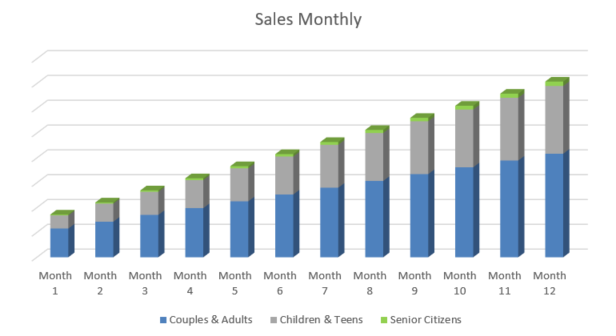
6.4 Sales Yearly:
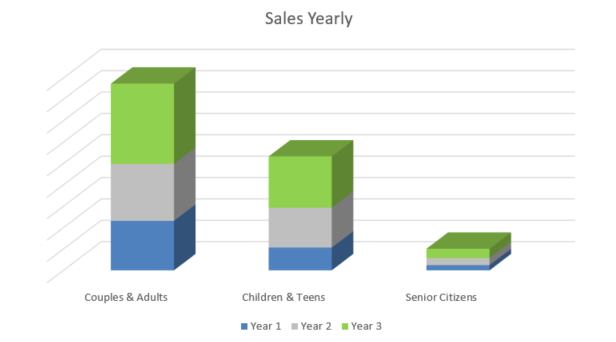
6.5 Sales Forecast
Our forecasted sales pattern is given in the following column chart:
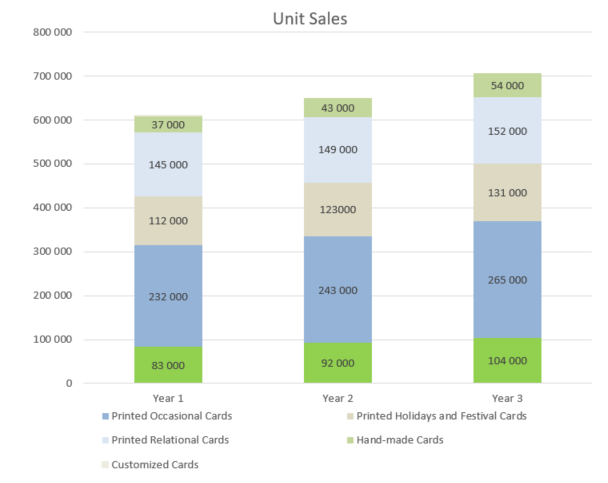
Personnel plan
It is highly advisable to prepare a personnel plan before you think about how to start a milk tea business plan templated bubble tea shop since it is one of the biggest contributing factors of the success of any business. The personnel plan of Sam’s Stop is as follows:
7.1 Company Staff
Sam will act as the CEO of the company and will initially hire following people:
- 1 Manager to manage the overall operations
- 1 Cashier to receive cash from the people
- 2 Accountants to maintain financial records
- 4 Sales Executives responsible for marketing and advertising the tea shop
- 10 Chefs for preparing drinks
- 10 Waiters to serve the customers
- 8 Cleaners to clean dishes and other facilities at the tea shop
Financial Plan
The final thing to do before you think about how to open milk tea room business model is to develop a comprehensive financial plan which will cover the detailed costs of startup.
8.1 Important Assumptions
| Plan Month | 1 | 2 | 3 |
| Current Interest Rate | 10.00% | 11.00% | 12.00% |
| Long-term Interest Rate | 10.00% | 10.00% | 10.00% |
| Tax Rate | 26.42% | 27.76% | 28.12% |
| Other | 0 | 0 | 0 |
8.2 Brake-even Analysis
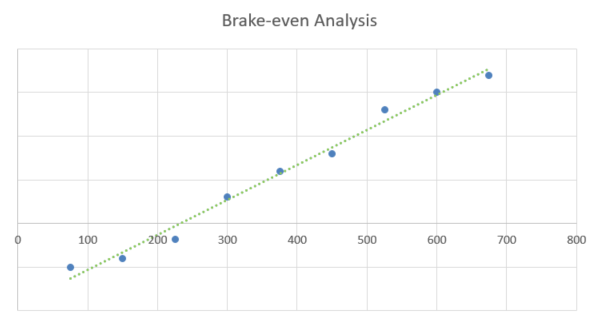
8.3 Projected Profit and Loss
8.3.1 profit monthly.
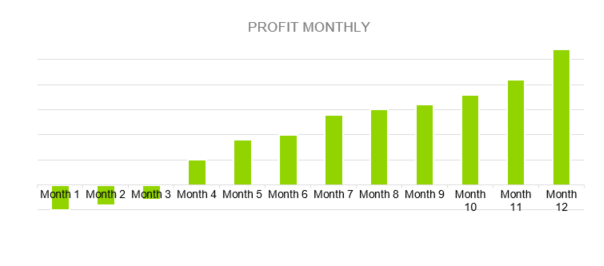
8.3.2 Profit Yearly
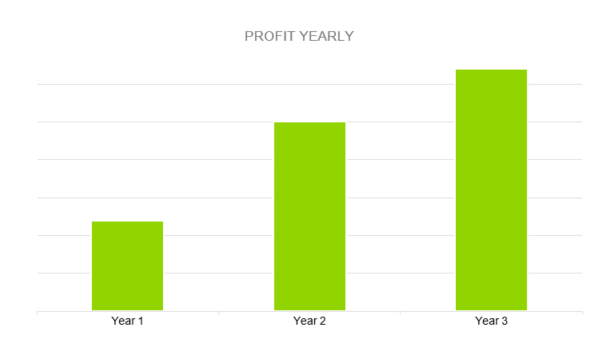
8.3.3 Gross Margin Monthly
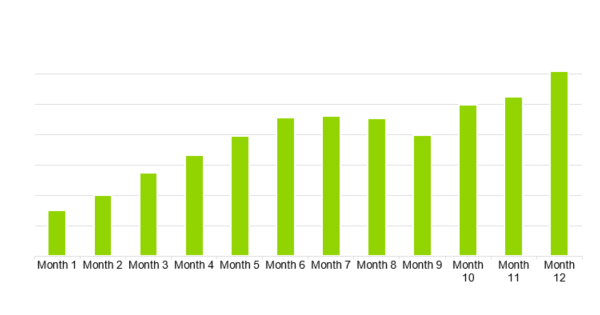
8.3.4 Gross Margin Yearly
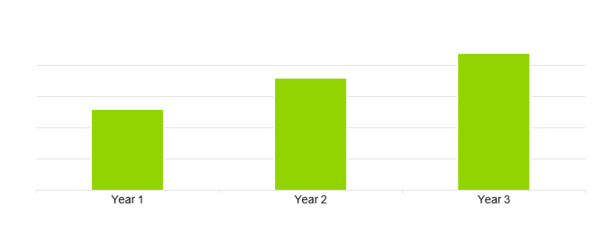
8.4 Projected Cash Flow
The following column diagram shows the projected cash flow.
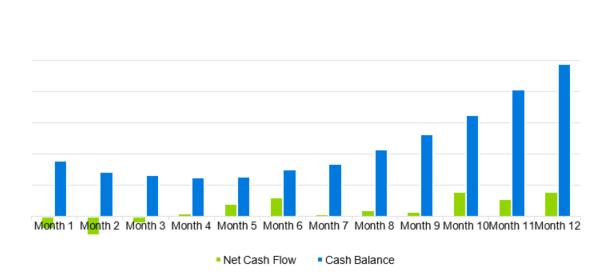
Download Bubble Tea Shop Business Plan in pdf
OGScapital also specializes in writing business plans such as a business plan for a sandwich shop , business plan of coffee shop , business plan of a butchery business startup , donut shop business plan , business plan for a grocery store , restaurant business plan templates and etc.
OGSCapital’s team has assisted thousands of entrepreneurs with top-rate business plan development, consultancy and analysis. They’ve helped thousands of SME owners secure more than $1.5 billion in funding, and they can do the same for you.

Ice Vending Machine Business Plan

OGScapital at the National Citizenship and Immigration Conference

How to Start a Plumbing Business in 2024: A Detailed Guide

Vegetable Farming Business Plan

Trading Business Plan

How To Write A Textile Manufacturing Business Plan

Any questions? Get in Touch!
We have been mentioned in the press:
Leave a Reply Cancel reply
Your email address will not be published. Required fields are marked *
Save my name, email, and website in this browser for the next time I comment.
Search the site:
Trending News
How to start a real estate business in the philippines .
- Business Ideas
- Human Resources
- Office Technology
- Starting a Business

Starting a Profitable Milk Tea Business
Disclosure: Small Business Philippines strives to provide relevant and accurate information in all its articles. However, some information in our articles may differ or might be outdated from what you can see or read directly from the establishments’ or businesses’ websites. Please get in touch with us directly for any discrepancies.
A milk tea business is a type of beverage business that specializes in selling milk tea, also known as bubble tea or boba tea. Milk tea originated in Taiwan and has gained popularity worldwide. It typically consists of a base tea (such as black tea, green tea, or oolong tea), milk or creamer, sweetener (usually sugar or syrup), and optional toppings like tapioca pearls, fruit jellies, or flavored popping boba.
In a milk tea business, the focus is on offering a variety of milk tea flavors and customizations to cater to different tastes and preferences. The menu may include classic milk tea options, as well as fruit-flavored teas, herbal teas, and specialty blends. Customers can choose the level of sweetness, ice, and toppings according to their preferences.
To run a successful milk tea business, entrepreneurs need to consider factors such as sourcing high-quality tea leaves, selecting fresh and premium ingredients, and maintaining consistency in taste and texture. Additionally, creating an inviting and comfortable ambiance in the store, providing excellent customer service, and implementing effective marketing strategies are essential for attracting and retaining customers.
Milk tea businesses can operate through different formats, including physical stores, kiosks, food trucks, or online platforms for delivery and takeout. The industry has seen continuous growth and innovation, with new flavors, unique toppings, and creative presentations being introduced to cater to evolving consumer demands.
When and Where to Start Your Milk Tea Business
1. crafting a business plan:, 2. securing funding:, 3. registering your business:, 4. sourcing quality ingredients and equipment:, 5. creating a captivating menu:, 6. hiring and training staff:, 7. marketing and promotion:, expert tips for success in the milk tea business, key takeaways.
Timing and location are crucial factors when launching a milk tea business. Consider conducting market research to identify areas with high foot traffic and a target audience that appreciates milk tea. Strategically positioning your business in bustling urban centers , near schools, or within commercial districts can significantly increase your chances of attracting customers.
How to Start a Milk Tea Business: Step-by-Step Guide
- Begin by outlining your business objectives, target market, and unique selling proposition .
- Conduct a thorough analysis of competitors, local regulations, and potential suppliers.
- Define your menu, pricing strategy, and marketing plan.
- Estimate your startup costs, including equipment, ingredients, staff, and marketing expenses.
- Explore funding options such as personal savings, loans, partnerships, or investor support.
- Develop a financial projection to demonstrate the profitability of your milk tea business .
- Comply with the l egal requirements by registering your business with the appropriate government agencies.
- Obtain necessary permits, licenses, and clearances to ensure a smooth and lawful operation.
- Establish relationships with reliable suppliers who can provide high-quality tea leaves, milk, sweeteners, and flavorings.
- Invest in equipment such as tea brewing machines, blenders, refrigeration units, and point-of-sale systems to streamline operations.
- Develop a menu that offers a diverse range of milk tea flavors, toppings, and customization options to cater to different preferences.
- Experiment with unique combinations and signature creations to differentiate your milk tea business from competitors.
- Recruit enthusiastic and customer-oriented staff members who can provide excellent service.
- Provide comprehensive training to ensure consistency in product preparation, hygiene practices, and customer engagement.
- Develop a compelling brand identity, including a catchy name, logo, and visually appealing store design.
- Leverage digital marketing channels, social media platforms, and influencer collaborations to build brand awareness and attract customers.
- Offer promotions, loyalty programs, and partnerships to incentivize repeat business and customer loyalty.
- Focus on product quality and consistency to build a loyal customer base.
- Stay updated with industry trends and introduce new flavors and seasonal offerings to keep customers engaged.
- Embrace sustainability by using eco-friendly packaging and promoting responsible sourcing practices.
- Foster positive relationships with suppliers and negotiate competitive pricing to maximize profitability.
- Prioritize exceptional customer service to enhance the overall experience and encourage word-of-mouth referrals.
- Starting a milk tea business in the Philippines presents a lucrative opportunity in the thriving F&B industry.
- Conduct thorough market research and choose a strategic location to attract your target audience.
- Develop a comprehensive business plan, secure funding, and register your business to ensure legal compliance.
- Source quality ingredients and equipment, create an enticing menu, and train staff to deliver exceptional service.
- Implement effective marketing strategies and stay innovative to stand out in the competitive milk tea market.
The milk tea business in the Philippines offers immense potential for entrepreneurs seeking success in the F&B industry. By following this comprehensive guide and implementing expert tips, you can embark on a profitable journey and carve your niche in the ever-growing milk tea market. Start brewing your dreams today and captivate customers with delightful milk tea creations. Cheers to your milk tea business success !

Starting a Clothing Manufacturing Business
Maximizing your savings account in the philippines.
Allan Martinez
Related posts, how to start a pet grooming business , how to start a clothing business in the philippines , small farm ideas: unlocking profitable opportunities , how to start a computer shop business , starting a buy and sell business in the philippines , 10 profitable small farm ideas and how to get started , leave a reply cancel reply.
You must be logged in to post a comment.

Understanding QuickBooks Online Pricing
Referral email sample , business directories , understanding checklist samples , local advertising , understanding basic sites , cross merchandising , understanding payroll in the philippines , product description sample pdf , how to make barcode , bookkeeping business , understanding free crm , inventory software for small business , customer service responses examples , employee information sheet , google business profile , understanding xero pricing , quickbooks self-employed , call logs , employee management .
Username or Email Address
Remember Me
Registration confirmation will be emailed to you.
Philippines Money Helper
We collect all helpful guide about finance
How to Create a Successful Business Plan for a Milk Tea Shop

Opening a milk tea shop can be a lucrative venture in today’s market. With the growing popularity of this beverage, it’s important to have a solid business plan in place to ensure your success. A well-thought-out plan will serve as your roadmap, guiding you through the various aspects of starting and running your milk tea shop.
One of the first steps in creating a successful business plan is to define your target market. Determine who your ideal customers are and what their preferences and needs are when it comes to milk tea. Conduct market research to gather valuable insights and data that will help you tailor your business to meet the demands of your target audience.
Next, you’ll need to outline your product and service offerings. Describe the different types of milk tea you’ll be offering, along with any additional menu items or specialty drinks. Consider incorporating unique flavors or ingredients to set your milk tea shop apart from competitors. Additionally, think about the overall customer experience you want to create, from the ambiance of your shop to the quality of your service.
Furthermore, it’s crucial to develop a comprehensive marketing strategy. This will involve identifying the most effective channels to reach your target market, such as social media, local advertising, or partnerships with other businesses. Consider offering promotions or discounts to attract customers and encourage repeat business. Your marketing strategy should be ongoing and adaptable to changes in the industry or shifts in customer preferences.
In conclusion, creating a successful business plan for a milk tea shop requires careful consideration of your target market, product offerings, and marketing strategy. By understanding your ideal customers, offering a unique and high-quality product, and implementing a well-rounded marketing plan, you’ll be well on your way to running a successful milk tea shop.
Table of Contents
Opening a milk tea shop can be an exciting and profitable venture. However, before diving into it, it’s essential to have a well-thought-out business plan. This plan will serve as a roadmap and guide you through the process of starting and running a successful milk tea shop.
Market Research: Start by conducting a thorough market research to understand the demand for milk tea in your area. Identify your target market, competitor analysis, and the potential for growth. This information will help you make informed decisions regarding location, pricing, and marketing strategies.
Unique Selling Proposition (USP): Determine what sets your milk tea shop apart from others. It could be a unique flavor combination, customization options, or organic and locally sourced ingredients. Your USP will give you a competitive edge in the market and attract customers.
Menu Selection: Develop a menu that offers a variety of milk tea flavors and add-ons. Consider customer preferences, dietary restrictions, and current trends. Experiment with different recipes to create signature drinks that will become customer favorites.
Location: Choose a location that has a high foot traffic, especially near schools, offices, or shopping areas. Ensure that it’s easily accessible, and there’s enough parking space. Consider the rent and lease terms while selecting the perfect location for your milk tea shop.
Supplier and Ingredients: Establish relationships with reliable suppliers to ensure a steady and quality supply of ingredients. Source for fresh milk, tea leaves, sweeteners, boba pearls, and any other necessary ingredients. Consistency and quality are crucial for customer satisfaction.
Staffing and Training: Hire a competent and friendly staff who can provide excellent customer service. Train them on product knowledge, proper tea brewing techniques, and efficient service. Create a positive work environment that fosters teamwork and productivity.
Marketing and Promotion: Develop a marketing strategy to create awareness about your milk tea shop. Utilize social media platforms, such as Instagram and Facebook, to showcase your products and engage with customers. Offer promotions, discounts, or loyalty programs to incentivize repeat customers.
Financial Projections: Prepare a detailed financial projection that includes startup costs, monthly expenses, revenue forecasts, and cash flow statements. This will help you understand the financial viability of your business and plan accordingly.
Continuous Improvement: Keep track of customer feedback and adapt your offerings accordingly. Regularly update your menu with new flavors and seasonal specials. Stay up-to-date with industry trends and incorporate innovative ideas to stay ahead of the competition.
In conclusion, creating a successful business plan for a milk tea shop requires thorough research, a unique selling proposition, a well-curated menu, a strategic location, reliable suppliers, trained staff, effective marketing strategies, and a solid financial plan. By following these steps and staying committed to continuous improvement, you can build a thriving milk tea shop that delights customers and achieves long-term success.
Market Research
Market research is an essential step in creating a successful business plan for a milk tea shop. This process involves gathering information about the market, potential customers, and competitors. By conducting thorough market research, you will be able to identify opportunities, understand customer preferences, and make informed decisions.
Here are some key steps to conduct market research for your milk tea shop:
1. Identify your target market:
Determine who your ideal customers are and segment them based on demographic factors such as age, gender, income, and location. Understanding your target market will help you tailor your products and marketing efforts to meet their specific needs.
2. Analyze competitors:
Study other milk tea shops in your area and analyze their offerings, pricing strategies, marketing tactics, and customer base. Identify the strengths and weaknesses of your competitors to differentiate your milk tea shop and attract customers.
3. Conduct surveys or interviews:
Collect feedback and opinions from potential customers to understand their preferences, tastes, and expectations. You can conduct online surveys or face-to-face interviews to gather valuable insights that will help you design a menu and create a unique customer experience.
4. Visit trade shows and industry events:
Attending trade shows and industry events related to the beverage or tea industry will provide you with valuable insights into the latest trends, innovations, and market dynamics. It will also give you the opportunity to network with industry professionals and suppliers.
5. Analyze industry reports and trends:
Stay up to date with industry reports, market trends, and consumer behavior studies related to the tea and beverage industry. This will help you understand the current market landscape and identify growth opportunities or potential challenges.
By conducting thorough market research, you will be well-equipped to develop a successful business plan for your milk tea shop. It will help you make informed decisions, create an appealing menu, and attract your target customers.
Identifying the target audience
Identifying the target audience is a crucial step in creating a successful business plan for a milk tea shop. The target audience refers to the specific group of people who are most likely to be interested in and purchase your products or services.
When identifying your target audience, it is important to consider factors such as age, gender, location, and interests. In the case of a milk tea shop, your target audience might include young adults and teenagers who are looking for a refreshing and trendy beverage option.
Market research can help you gain insights into your target audience. You can conduct surveys, interviews, and analyze customer data to understand their preferences and behaviors. This information can then be used to tailor your products, marketing messages, and overall business strategy to effectively reach and engage your target audience.
Additionally, it is important to consider the competition in your target market. Are there already established milk tea shops catering to a similar audience? Is there a gap in the market that you can fill with your unique offerings? Understanding the competitive landscape can help you refine your target audience and develop a competitive advantage.
By identifying and understanding your target audience, you can create a business plan that is specific, targeted, and appealing to the people who are most likely to become loyal customers. Your marketing efforts, branding, and product offerings can then align with the needs and preferences of your target audience, leading to the success of your milk tea shop.
Analyzing the competition
Before starting your milk tea shop, it is crucial to analyze the competition in your target market. Understanding the strengths and weaknesses of your competitors will help you position your business effectively and develop strategies to stand out.
Here are some steps to consider when analyzing the competition:
Identify your direct competitors: Research and identify other milk tea shops operating in your area. Look for their location, menu, pricing, target audience, and branding. Analyze their strengths and weaknesses to identify opportunities and areas for improvement that can differentiate your business.
Study their menu: Examine the variety of flavors, toppings, and types of teas offered by your competitors. Take note of their specialty drinks and unique combinations. This will help you understand the preferences of your target market and identify gaps in the market that you can fill.
Analyze their pricing: Observe the pricing strategies employed by your competitors. Determine whether they focus on offering premium, mid-range, or budget-friendly options. Pricing can impact your positioning in the market, so it’s important to understand how your competitors set their prices and what value they offer customers in return.
Evaluate their branding and marketing: Assess the branding and marketing strategies of your competitors. Look at their logos, store designs, social media presence, and online reviews. Consider how they communicate with their customers and what sets them apart from others. This will help you develop a unique brand and marketing approach that appeals to your target market.
Assess customer feedback: Read customer reviews and gather feedback on your competitors’ milk tea shops. Pay attention to both positive and negative comments, as they can provide insights into what customers appreciate and what can be improved. Use this information to tailor your products and services to meet customer preferences.
Identify market trends: Stay updated on the latest trends and innovations in the milk tea industry. This includes new flavors, ingredients, brewing techniques, and packaging. By keeping an eye on industry trends, you can adapt and respond to changing customer preferences and stay ahead of your competition.
Remember, analyzing the competition is not about copying their strategies but rather understanding their strengths and weaknesses. This will help you develop a unique value proposition that sets your milk tea shop apart in the market.
Concept and Branding
In order to create a successful business plan for a milk tea shop, it is important to develop a strong concept and branding strategy. Your concept should revolve around the idea of offering unique and high-quality milk tea beverages to customers.
To start, you need to determine what sets your milk tea shop apart from competitors. Consider factors such as the ingredients you use, the brewing techniques you employ, and the flavors you offer. Highlighting these unique aspects will help differentiate your brand from others in the market.
Additionally, branding plays a significant role in attracting and retaining customers. Your brand should reflect the core values and personality of your milk tea shop. Consider factors such as the visual identity, including the logo, colors, and overall design aesthetic. It should align with the target audience and appeal to their preferences.
Branding also extends to the overall experience of the milk tea shop. Think about the ambiance, music, and customer service. Create an atmosphere that is inviting and comfortable for customers, encouraging them to stay and enjoy their milk tea.
Furthermore, developing a strong online presence is crucial for modern businesses. Utilize social media platforms to engage with customers, share updates and promotions, and create a community around your milk tea shop. Consider partnering with influencers or running targeted advertisements to increase brand awareness and attract new customers.
By focusing on your milk tea shop’s unique concept and developing a strong brand identity, you can create a successful business plan that will attract and retain customers, helping your venture thrive in the competitive market.
Defining the unique selling proposition (USP)
Having a strong unique selling proposition (USP) is crucial for the success of a milk tea shop. Your USP is what sets you apart from your competitors and attracts customers to choose your shop over others.
To define your USP, you need to consider what makes your milk tea shop unique and what value it brings to customers. Ask yourself questions such as:
- What is different about your milk tea shop compared to others? It could be a special tea blend, unique flavors, or innovative brewing techniques.
- What problems or pain points does your milk tea shop solve for customers? It could be providing a healthier alternative to sugary beverages or offering a cozy and inviting atmosphere for customers to relax and enjoy their tea.
- What is the emotional experience your milk tea shop provides? It could be a sense of nostalgia, happiness, or relaxation that customers feel when they visit your shop.
Once you have identified your unique aspects, distill them into a concise and compelling message that can effectively communicate your USP to your target audience.
For example:
“At ABC Milk Tea Shop, we stand out from the crowd by offering a wide range of organic tea blends sourced from sustainable farms. Each cup of our milk tea is carefully crafted to bring out the natural flavors and aromas, providing our customers with a truly unique and wholesome tea-drinking experience. With our commitment to quality and sustainability, our customers can enjoy their milk tea with peace of mind, knowing that they are making a healthier choice for themselves and the environment.”
By defining and effectively communicating your unique selling proposition, you can differentiate your milk tea shop and attract customers who align with your values and preferences.
Creating a memorable brand identity
When starting a milk tea shop, one of the key factors for success is creating a memorable brand identity. Your brand identity is not just your logo or the name of your shop, but it encompasses everything that represents your business and what it stands for.
To create a memorable brand identity for your milk tea shop, consider the following tips:
1. Define your brand values:
Start by identifying the core values that your milk tea shop represents. What do you want your brand to be known for? Is it high quality ingredients, unique flavors, or exceptional customer service? Define these values and ensure that they are communicated consistently throughout your branding efforts.
2. Choose a unique name and logo:
Selecting a name and designing a logo are crucial steps in creating a memorable brand identity. Your name should be catchy and easy to remember, while the logo should be visually appealing and representative of what your shop offers.
3. Develop a consistent visual identity:
Consistency is key when it comes to branding. Choose a color scheme, typography, and overall visual style that align with your brand values. Use these elements consistently across your shop’s signage, menu, packaging, and online presence to create a cohesive and recognizable brand identity.
4. Craft a compelling brand story:
A compelling brand story can help connect with your customers on a deeper level. Share the journey of how your milk tea shop came to be, including the inspiration behind the flavors and the passion that drives your business. This story will help create an emotional connection with your customers and make your brand more memorable.
5. Engage with your target audience:
Building a strong brand identity requires engaging with your target audience. Use social media platforms and other marketing channels to interact with your customers, listen to their feedback, and build relationships. By understanding their needs and preferences, you can adapt your brand identity to better resonate with your target audience.
Remember, a memorable brand identity takes time and effort to develop. By following these tips and staying true to your brand values, you can create a strong and memorable brand for your milk tea shop.
Designing an attractive menu

When designing the menu for your milk tea shop, it’s important to create an attractive and visually appealing layout that will catch the attention of your customers. A well-designed menu can make a significant impact on the overall dining experience and can be an effective marketing tool for your business.
Here are some tips to help you design an attractive menu:
- Use high-quality images: Including high-resolution images of your milk tea options can entice customers and make their mouths water. Make sure the images are not only visually appealing but also accurately represent the actual product.
- Organize the menu: Arrange your menu items in a clear and logical manner. Categorize your milk tea flavors, toppings, and other options to make it easy for customers to find what they’re looking for. Consider the flow of how customers would read the menu, starting from the most popular or special flavors.
- Highlight special offers: If you have any promotions or special offers, make sure to feature them prominently on the menu. Use eye-catching colors or graphics to draw attention to these deals and encourage customers to take advantage of them.
- Use descriptive language: Use descriptive words to describe your milk tea flavors and toppings. Incorporate adjectives that evoke emotions or sensory experiences, such as “creamy,” “refreshing,” or “indulgent.” This will help customers imagine what the drink would taste like and entice them to try it.
- Include nutritional information: As more and more customers become health-conscious, it’s important to provide them with the nutritional information of your milk tea options. Include details such as calories, sugar content, and any allergens present. This transparency will build trust with your customers.
- Choose a visually appealing font and color scheme: Your menu’s font and color scheme should align with the overall branding of your milk tea shop. Choose fonts that are easy to read and colors that complement each other. Avoid using too many different fonts or colors, as this can make the menu look cluttered.
Remember, your menu is a reflection of your brand and your milk tea offerings. Take the time to carefully design it to make a positive impression on your customers. Regularly review and update your menu to keep it fresh and offer new choices to keep customers coming back for more.
Location and Equipment
Choosing the right location for your milk tea shop is crucial to its success. You want to find a high-traffic area with a target demographic that would be interested in your product. Look for a location near schools, office buildings, or shopping centers, where there is a steady flow of potential customers.
Once you have found the ideal location, you need to ensure that you have the necessary equipment to run your milk tea shop efficiently. Some of the essential equipment includes:
| Equipment | Description |
|---|---|
| Tea brewing equipment | Invest in high-quality tea brewing equipment to ensure a consistent taste and quality of your milk tea. This may include tea brewing machines, tea pots, infusers, and thermometers. |
| Blenders and mixers | These are essential for making milk tea with toppings like pearls or jelly. Invest in powerful blenders and mixers to blend the tea and other ingredients together smoothly. |
| Refrigeration units | Having refrigeration units is important for storing milk, fresh ingredients, and toppings to maintain their freshness and quality. |
| Cash register and POS system | To efficiently manage your sales transactions and keep track of your inventory, invest in a reliable cash register and a POS system. |
| Furniture and fixtures | Make sure to have comfortable seating, tables, and counter space for customers to enjoy their milk tea. Also, consider having attractive signage and decorations to create an inviting atmosphere. |
| Dishware and utensils | Stock up on a sufficient supply of cups, lids, straws, and spoons for serving your milk tea. Opt for eco-friendly and sustainable options, such as biodegradable or reusable products. |
Additionally, it’s important to ensure that your milk tea shop meets all health and safety regulations. This may include obtaining necessary permits and licenses, implementing proper waste disposal practices, and maintaining cleanliness and hygiene in your establishment.
Investing in the right location and equipment is essential for the smooth operation and success of your milk tea shop. Take the time to research and choose wisely, as it can significantly impact your business’s performance and profitability.
Choosing the ideal location for your milk tea shop
When it comes to running a successful milk tea shop, choosing the right location is crucial. The location can determine the influx of customers, visibility, and overall success of your business. Here are some factors to consider when selecting the ideal location for your milk tea shop:
1. Foot Traffic: Look for a location with a high volume of foot traffic. Areas near shopping malls, universities, office complexes, or busy streets tend to have a steady flow of potential customers. The more people passing by your shop, the higher the chances of attracting customers.
2. Target Customer Base: Consider your target customer base and choose a location that aligns with their preferences. If you are targeting a young demographic, you might want to locate your milk tea shop near colleges or residential areas with a high student population. Research the demographics of the area to ensure there is a demand for milk tea among the local community.
3. Competition: Assess the level of competition in the area. While some competition can be healthy, too much competition can overshadow your business. Look for a location where there is a demand for milk tea but fewer competitors, or offer a unique selling proposition to differentiate yourself from the competition.
4. Accessibility: Ensure your milk tea shop is easily accessible by both pedestrians and vehicles. Choose a location with ample parking space and easy access to public transportation. Consider the ease of entering and exiting the premises to provide convenience to your customers.
5. Space and Layout: The physical space of your milk tea shop is essential for creating a pleasant and comfortable environment for your customers. Look for a location that has enough space for your equipment, seating area, and a separate area for food preparation. Consider the layout to ensure smooth traffic flow and maximize the use of space.
6. Rent and Operating Costs: Consider the rental and operating costs associated with the location. Ensure that the rent is within your budget and that you can afford the ongoing expenses such as utilities, maintenance, and insurance. Be cautious of high rental costs that may eat into your profit margins.
7. Future Growth Potential: Evaluate the growth potential of the location. Research any upcoming developments or changes in the area that may attract more customers or increase the value of the property in the future. This will help ensure the long-term success of your milk tea shop.
By considering these factors, you can choose the ideal location for your milk tea shop and increase the likelihood of success in the competitive market.
Selecting the necessary equipment
When starting a milk tea shop, it is important to select the necessary equipment that will help you create and serve high-quality milk tea beverages. Here are some key items to consider:
Milk Tea Brewer: Invest in a high-quality milk tea brewer that can handle a large volume of tea brewing. Look for a brewer with temperature control settings and a large capacity to ensure consistent and efficient brewing processes.
Sealing Machine: A sealing machine is essential for properly sealing the cups with plastic film, which helps to keep the drink fresh and prevent leakage. Look for a sealing machine that is easy to use, durable, and has adjustable sealing settings to cater to different cup sizes.
Refrigeration Units: You will need refrigeration units to store and display the milk tea ingredients such as milk, syrups, and toppings. Invest in refrigeration units that are energy-efficient, have proper temperature control, and provide ample storage space to accommodate your inventory.
Blenders and Shakers: Blenders and shakers are important tools for creating well-mixed milk tea beverages with a smooth and frothy texture. Look for high-quality blenders with variable speed options and shakers that are easy to use and clean.
Utensils and Accessories: It is essential to have the necessary utensils and accessories such as stirring spoons, straws, cups, and napkins. Consider using eco-friendly options to align with the growing trend of sustainable practices.
Water Filtration System: A water filtration system is crucial for ensuring the quality and taste of your milk tea. Invest in a filtration system that removes impurities and provides clean and purified water for brewing tea.
Point of Sale (POS) System: A modern and efficient POS system will help you streamline your operations, manage inventory, and handle transactions efficiently. Look for a POS system that is user-friendly, integrates with other software or applications, and provides detailed reports on sales and inventory.
Security Systems: Protecting your milk tea shop and its assets is important. Install security systems such as CCTV cameras, alarms, and access control systems to deter theft and monitor activities within the shop.
Remember to do thorough research, compare prices, and consider your specific needs before purchasing equipment for your milk tea shop. Selecting the right equipment will contribute to the overall success and efficiency of your business.
Financial Planning
Financial planning is a crucial aspect of creating a successful business plan for a milk tea shop. It involves analyzing the projected revenue, costs, and expenses to determine the financial viability of the business.
Here are some key steps to consider when developing the financial plan for your milk tea shop:
- Start-up Costs: Identify and estimate all the costs associated with launching your milk tea shop. This includes expenses such as rent, renovations, equipment, supplies, licenses, and permits.
- Revenue Projections: Conduct market research to determine the potential demand for milk tea in your target location. Estimate the number of customers, the projected sales volume per day, and the average transaction value. These numbers will help you project your monthly and annual revenue.
- Operating Expenses: Determine the ongoing expenses required to run your milk tea shop. This includes costs such as rent, utilities, salaries, inventory, marketing, and other overhead expenses. It is important to accurately estimate these expenses to understand your monthly and annual operating costs.
- Profitability Analysis: Analyze your revenue projections and operating expenses to determine the profitability of your milk tea shop. Calculate metrics such as gross profit margin, operating profit margin, and net profit margin to assess the financial health of your business.
- Break-even Analysis: Determine the point at which your milk tea shop will start generating a profit. Calculate the break-even sales volume and break-even sales revenue to understand how much you need to sell in order to cover your costs and start making a profit.
- Financial Forecast: Create a financial forecast for your milk tea shop, including projected sales, expenses, and profit margin, for the next three to five years. This will help you anticipate future financial performance and make informed decisions.
- Funding and Financing: Determine how much funding you will need to start and sustain your milk tea shop. Consider options such as personal savings, loans, grants, or partnerships. Create a financial strategy that outlines your funding sources and how you plan to repay any loans.
Remember, financial planning is an ongoing process. It is important to regularly review and update your financial plan to ensure the continued success and profitability of your milk tea shop.
Estimating Startup Costs
When starting a milk tea shop, it is important to carefully estimate the startup costs involved. This will help you plan your budget and secure the necessary funds. Here are some key areas to consider when estimating your startup costs:
- Location: The cost of renting or purchasing a suitable space for your milk tea shop is one of the major expenses. Consider factors such as the size, location, and condition of the space, as well as any necessary renovations.
- Equipment: You will need various equipment to operate your milk tea shop, such as blenders, tea brewing machines, refrigerators, and furniture. Research the costs of purchasing or leasing these items, and include them in your budget.
- Inventory: Estimate the initial inventory you will need to stock your milk tea shop with ingredients, tea leaves, cups, lids, straws, and other supplies. Consider the variety of flavors and options you plan to offer to calculate the required quantities.
- Licensing and permits: Depending on your location, you may need to obtain certain licenses and permits to legally operate a milk tea shop. Research the requirements and associated costs for obtaining these documents.
- Marketing and advertising: Allocate a portion of your startup costs for marketing and advertising your milk tea shop. This can include strategies such as creating a website, printing promotional materials, running social media ads, and hosting grand opening events.
- Employee wages and training: If you plan to hire employees, consider the wages you will need to pay them, as well as any training costs. Factor in the number of employees you need and their roles within the milk tea shop.
- Utilities: Include estimated costs for utilities such as electricity, water, and internet services in your startup budget. Consider the specific needs of your milk tea shop, such as high-powered blenders or specialized water filtration systems.
It is important to be thorough and realistic when estimating your startup costs. Consider obtaining quotes from suppliers and contractors, as well as researching industry averages. Remember to set aside a contingency fund for unexpected expenses that may arise during the startup phase.
By carefully estimating your startup costs, you can create a solid business plan and ensure that you have adequate funding to launch and sustain your milk tea shop successfully.
Creating a budget and financial projections
One of the key components of a successful business plan for a milk tea shop is creating a budget and financial projections. This section outlines the expected costs and revenues associated with starting and operating the business.
1. Startup costs: Begin by estimating the initial expenses required to open the milk tea shop. This may include costs such as leasehold improvements, equipment purchases, licenses and permits, initial inventory, marketing expenses, and legal fees.
2. Operating expenses: Identify the ongoing costs of running the milk tea shop. This can include expenses such as rent, utilities, payroll, raw materials, packaging, marketing and advertising, insurance, and any other overhead expenses.
3. Sales projections: Determine the expected revenue streams for the milk tea shop. Estimate the number of customers you anticipate serving per day or month and calculate the average transaction value. Consider factors such as market demand, pricing strategy, location, and competition when making these projections.
4. Profit and loss statement: Use the estimated startup and operating costs, along with the sales projections, to create a profit and loss statement. This statement will help you determine the expected profitability of the milk tea shop, as well as identify areas where costs may need to be adjusted or additional revenue streams should be explored.
5. Cash flow projections: Analyze the cash inflows and outflows of the milk tea shop to create cash flow projections. Determine when cash will be coming in and going out of the business, ensuring that there is enough cash on hand to cover expenses during slower periods or unforeseen circumstances.
6. Funding requirements: If you plan to seek financing for your milk tea shop, clearly outline the funding requirements in this section. Identify how much capital you need to start the business, any loan or investment options you are considering, and how the funds will be used.
Creating a comprehensive budget and financial projections can help you understand the financial viability of your milk tea shop business idea. It will also serve as a guide to make informed decisions and identify potential financial risks and opportunities.
Determining pricing strategies

When creating a pricing strategy for your milk tea shop, it’s important to consider various factors to ensure profitability and competitiveness in the market. Here are some strategies to help you determine the right pricing model:
- Cost-based pricing: Calculate all the costs involved in running your milk tea shop, including ingredients, labor, rent, utilities, and overhead expenses. Add a profit margin that reflects your desired profitability and set a price accordingly. This approach ensures that your pricing covers all expenses and generates a profit.
- Market-based pricing: Research the prices of milk tea products offered by your competitors in the market. Analyze their offerings, quality, and brand image. Set your prices accordingly to either match or differentiate yourself from the competition. Keep in mind that setting a lower price might attract more customers, but it could also impact your profit margins.
- Value-based pricing: Determine the perceived value of your milk tea products in the minds of your customers. Consider factors such as taste, ingredients, presentation, and customer experience. Set a price that aligns with the value you offer. This strategy works well if you position your milk tea shop as a premium or unique brand.
- Bundling strategy: Consider offering bundled pricing options, such as combo deals or special promotions. This strategy can encourage customers to try multiple items from your menu and increase the average transaction value. Make sure to calculate the costs and profit margin for each item in the bundle to ensure profitability.
- Dynamic pricing: Implement a dynamic pricing strategy that allows you to adjust prices based on demand, time of day, seasonality, or other factors. You can offer discounts during off-peak hours to attract more customers or increase prices during high-demand periods to maximize revenue.
Ultimately, the right pricing strategy for your milk tea shop will depend on a combination of factors, including the market you operate in, your target customers, your desired brand positioning, and your overall business goals. Regularly evaluate and adjust your pricing strategy to ensure it remains competitive and profitable in the long run.
Question-answer:
What are the key elements to include in a business plan for a milk tea shop.
A successful business plan for a milk tea shop should include key elements such as an executive summary, market analysis, competitive analysis, target market segmentation, marketing plan, operational plan, organizational structure, financial projections, and risk management strategies.
What should be considered when conducting a market analysis for a milk tea shop?
When conducting a market analysis for a milk tea shop, it is important to consider factors such as the size of the target market, consumer trends and preferences, competitor analysis, pricing strategies, and potential barriers to entry. This analysis will help in understanding the market demand and identifying opportunities and challenges.
How can a milk tea shop attract customers and build a loyal customer base?
A milk tea shop can attract customers and build a loyal customer base by offering high-quality and unique tea flavors, providing excellent customer service, creating a comfortable and inviting ambiance, utilizing effective marketing strategies such as social media advertising and collaborations with influencers, offering loyalty programs and promotions, and regularly seeking feedback from customers to improve the overall experience.
What are some potential risks that a milk tea shop may face?
Some potential risks that a milk tea shop may face include increased competition from other tea shops or coffee establishments, changes in consumer preferences, fluctuations in ingredient prices, difficulties in finding reliable suppliers, challenges in maintaining consistent product quality, and unforeseen events such as natural disasters or health crises that may impact the business operations.
Related Posts:
- Milk Tea Business Plan Example Tips and Strategies for…
- How to Create a Successful Business Plan for Milk Tea
- Milk Tea Franchise The Ultimate Guide to Starting Your Own…
- Beginner's Guide How to Start a Milktea Business
- Best Milk Tea Franchise Philippines - Find Your Perfect…
- Creating a Successful Business Plan for your Milk Tea Shop
Related Post
Manila zoo entrance fee 2023 updated rates and information, explore unique handmade crafts from philippines in our etsy shop, sss paternity leave benefits rights and policies, leave a reply cancel reply.
Your email address will not be published. Required fields are marked *
Save my name, email, and website in this browser for the next time I comment.
Credit Card Activation BPI A Step-by-Step Guide to Activating Your BPI Credit Card

Tea Shop Business Plan Template
Written by Dave Lavinsky

Tea Shop Business Plan
Over the past 20+ years, we have helped over 500 entrepreneurs and business owners create business plans to start and grow their tea shops.
If you’re unfamiliar with creating a tea shop business plan, you may think creating one will be a time-consuming and frustrating process. For most entrepreneurs it is, but for you, it won’t be since we’re here to help. We have the experience, resources, and knowledge to help you create a great business plan.
In this article, you will learn some background information on why business planning is important. Then, you will learn how to write a tea shop business plan step-by-step so you can create your plan today.
Download our Ultimate Business Plan Template here >
What is a Tea Shop Business Plan?
A business plan provides a snapshot of your tea shop as it stands today, and lays out your growth plan for the next five years. It explains your business goals and your strategies for reaching them. It also includes market research to support your plans.
Why You Need a Business Plan for a Tea Shop
If you’re looking to start a tea shop or grow your existing tea shop, you need a business plan. A business plan will help you raise funding, if needed, and plan out the growth of your tea shop to improve your chances of success. Your tea shop business plan is a living document that should be updated annually as your company grows and changes.
Sources of Funding for Tea Shops
With regards to funding, the main sources of funding for a tea shop are personal savings, credit cards, bank loans, and angel investors. When it comes to bank loans, banks will want to review your business plan and gain confidence that you will be able to repay your loan and interest. To acquire this confidence, the loan officer will not only want to ensure that your financials are reasonable, but they will also want to see a professional plan. Such a plan will give them the confidence that you can successfully and professionally operate a business. Personal savings and bank loans are the most common funding paths for tea shops.
Finish Your Business Plan Today!
How to write a business plan for a tea shop.
If you want to start a tea shop or expand your current one, you need a business plan. The guide below details the necessary information for how to write each essential component of your tea shop business plan.
Executive Summary
Your executive summary provides an introduction to your business plan, but it is normally the last section you write because it provides a summary of each key section of your plan.
The goal of your executive summary is to quickly engage the reader. Explain to them the kind of tea shop you are running and the status. For example, are you a startup, do you have a tea shop that you would like to grow, or are you operating a chain of tea shops?
Next, provide an overview of each of the subsequent sections of your plan.
- Give a brief overview of the tea shop industry.
- Discuss the type of tea shop you are operating.
- Detail your direct competitors. Give an overview of your target customers.
- Provide a snapshot of your marketing strategy. Identify the key members of your team.
- Offer an overview of your financial plan.
Company Overview
In your company overview, you will detail the type of tea shop you are operating.
For example, you might specialize in one of the following types of tea shops:
- Loose leaf tea shop: This type of tea shop specializes in selling a variety of blends of loose leaf tea. Customers can often sample the tea before purchasing some to take home.
- Tea room or cafe: This type of tea shop sells food, tea, and other beverages in a dine-in setting.
- Tea bar: This type of tea shop offers a variety of tea to drink at the bar or to-go, similar to a coffee shop.
- Online tea shop: This type of tea shop sells a variety of different kinds of tea through an ecommerce site.
In addition to explaining the type of tea shop you will operate, the company overview needs to provide background on the business.
Include answers to questions such as:
- When and why did you start the business?
- What milestones have you achieved to date? Milestones could include the number of customers served, the number of drinks sold, and reaching $X amount in revenue, etc.
- Your legal business Are you incorporated as an S-Corp? An LLC? A sole proprietorship? Explain your legal structure here.
Industry Analysis
In your industry or market analysis, you need to provide an overview of the tea shop industry. While this may seem unnecessary, it serves multiple purposes.
First, researching the tea shop industry educates you. It helps you understand the market in which you are operating.
Secondly, market research can improve your marketing strategy, particularly if your analysis identifies market trends.
The third reason is to prove to readers that you are an expert in your industry. By conducting the research and presenting it in your plan, you achieve just that.
The following questions should be answered in the industry analysis section of your tea shop business plan:
- How big is the tea shop industry (in dollars)?
- Is the market declining or increasing?
- Who are the key competitors in the market?
- Who are the key suppliers in the market?
- What trends are affecting the industry?
- What is the industry’s growth forecast over the next 5 – 10 years?
- What is the relevant market size? That is, how big is the potential target market for your tea shop? You can extrapolate such a figure by assessing the size of the market in the entire country and then applying that figure to your local population.
Customer Analysis
The customer analysis section of your tea shop business plan must detail the customers you serve and/or expect to serve.
The following are examples of customer segments: individuals, schools, families, and corporations.
As you can imagine, the customer segment(s) you choose will have a great impact on the type of tea shop you operate. Clearly, individuals would respond to different marketing promotions than corporations, for example.
Try to break out your target customers in terms of their demographic and psychographic profiles. With regards to demographics, including a discussion of the ages, genders, locations, and income levels of the potential customers you seek to serve.
Psychographic profiles explain the wants and needs of your target customers. The more you can recognize and define these needs, the better you will do in attracting and retaining your customers.
Finish Your Tea Shop Business Plan in 1 Day!
Don’t you wish there was a faster, easier way to finish your business plan?
With Growthink’s Ultimate Business Plan Template you can finish your plan in just 8 hours or less!
Competitive Analysis
Your competitive analysis should identify the indirect and direct competitors your business faces and then focus on the latter.
Direct competitors are other tea shops.
Indirect competitors are other options that customers have to purchase from that aren’t directly competing with your product or service. This includes other types of cafes, beverage retailers, or coffee shops. You need to mention such competition as well.
For each such competitor, provide an overview of their business and document their strengths and weaknesses. Unless you once worked at your competitors’ businesses, it will be impossible to know everything about them. But you should be able to find out key things about them such as
- What types of customers do they serve?
- What type of tea shop are they?
- What is their pricing (premium, low, etc.)?
- What are they good at?
- What are their weaknesses?
With regards to the last two questions, think about your answers from the customers’ perspective. And don’t be afraid to ask your competitors’ customers what they like most and least about them.
The final part of your competitive analysis section is to document your areas of competitive advantage. For example:
- Will you make it easier for your customers to acquire your products or services?
- Will you offer products or services that your competition doesn’t?
- Will you provide better customer service?
- Will you offer better pricing?
Think about ways you will outperform your competition and document them in this section of your plan.
Marketing Plan
Traditionally, a marketing plan includes the four P’s: Product, Price, Place, and Promotion. For a tea shop business plan, your marketing strategy should include the following:
Product : In the product section, you should reiterate the type of tea shop that you documented in your company overview. Then, detail the specific products or services you will be offering. For example, will you provide loose leaf tea, in-shop dining, or tea accessories?
Price : Document the prices you will offer and how they compare to your competitors. Essentially in the product and price sub-sections of your plan, you are presenting the products and/or services you offer and their prices.
Place : Place refers to the site of your tea shop. Document where your company is situated and mention how the site will impact your success. For example, is your tea shop located in a busy retail district, a business district, a standalone shop, or purely online? Discuss how your site might be the ideal location for your customers.
Promotions : The final part of your tea shop marketing plan is where you will document how you will drive potential customers to your location(s). The following are some promotional methods you might consider:
- Advertise in local papers, radio stations and/or magazines
- Reach out to websites
- Distribute flyers
- Engage in email marketing
- Advertise on social media platforms
- Improve the SEO (search engine optimization) on your website for targeted keywords
Operations Plan
While the earlier sections of your business plan explained your goals, your operations plan describes how you will meet them. Your operations plan should have two distinct sections as follows.
Everyday short-term processes include all of the tasks involved in running your tea shop, including answering calls, greeting customers, taking orders, collecting payments, etc.
Long-term goals are the milestones you hope to achieve. These could include the dates when you expect to acquire your Xth customer, or when you hope to reach $X in revenue. It could also be when you expect to expand your tea shop to a new city.
Management Team
To demonstrate your tea shop’s potential to succeed, a strong management team is essential. Highlight your key players’ backgrounds, emphasizing those skills and experiences that prove their ability to grow a company.
Ideally, you and/or your team members have direct experience in managing tea shops. If so, highlight this experience and expertise. But also highlight any experience that you think will help your business succeed.
If your team is lacking, consider assembling an advisory board. An advisory board would include 2 to 8 individuals who would act as mentors to your business. They would help answer questions and provide strategic guidance. If needed, look for advisory board members with experience in managing a tea shop or successfully running a small medical practice.
Financial Plan
Your financial plan should include your 5-year financial statement broken out both monthly or quarterly for the first year and then annually. Your financial statements include your income statement, balance sheet, and cash flow statements.
Income Statement
An income statement is more commonly called a Profit and Loss statement or P&L. It shows your revenue and then subtracts your costs to show whether you turned a profit or not.
In developing your income statement, you need to devise assumptions. For example, will you expect to serve 20 customers per day, and will you offer discounts for repeat customers? And will sales grow by 2% or 10% per year? As you can imagine, your choice of assumptions will greatly impact the financial forecasts for your business. As much as possible, conduct research to try to root your assumptions in reality.
Balance Sheets
Balance sheets show your assets and liabilities. While balance sheets can include much information, try to simplify them to the key items you need to know about. For instance, if you spend $50,000 on building out your tea shop, this will not give you immediate profits. Rather it is an asset that will hopefully help you generate profits for years to come. Likewise, if a lender writes you a check for $50,000, you don’t need to pay it back immediately. Rather, that is a liability you will pay back over time.
Cash Flow Statement
Your cash flow statement will help determine how much money you need to start or grow your business, and ensure you never run out of money. What most entrepreneurs and business owners don’t realize is that you can turn a profit but run out of money and go bankrupt.
When creating your Income Statement and Balance Sheets be sure to include several of the key costs needed in starting or growing a tea shop:
- Cost of equipment and supplies
- Payroll or salaries paid to staff
- Business insurance
- Other start-up expenses (if you’re a new business) like legal expenses, permits, computer software, and equipment
Attach your full financial projections in the appendix of your plan along with any supporting documents that make your plan more compelling. For example, you might include your tea shop location lease or testimonials from happy customers.
Writing a business plan for your tea shop is a worthwhile endeavor. If you follow the template above, by the time you are done, you will truly be an expert. You will understand the tea shop industry, your competition, and your customers. You will develop a marketing strategy and will understand what it takes to launch and grow a successful tea shop.
Tea Shop Business Plan FAQs
What is the easiest way to complete my tea shop business plan.
Growthink's Ultimate Business Plan Template allows you to quickly and easily write your tea shop business plan.
How Do You Start a Tea Shop Business?
Starting a tea shop business is easy with these 14 steps:
- Choose the Name for Your Tea Shop Business
- Create Your Tea Shop Business Plan
- Choose the Legal Structure for Your Tea Shop Business
- Secure Startup Funding for Your Tea Shop Business (If Needed)
- Secure a Location for Your Business
- Register Your Tea Shop Business with the IRS
- Open a Business Bank Account
- Get a Business Credit Card
- Get the Required Business Licenses and Permits
- Get Business Insurance for Your Tea Shop Business
- Buy or Lease the Right Tea Shop Business Equipment
- Develop Your Tea Shop Business Marketing Materials
- Purchase and Setup the Software Needed to Run Your Tea Shop Business
- Open for Business
Learn more about how to start your own tea shop business .
Don’t you wish there was a faster, easier way to finish your Tea Shop business plan?
OR, Let Us Develop Your Plan For You
Since 1999, Growthink has developed business plans for thousands of companies who have gone on to achieve tremendous success. Click here to see how Growthink’s business plan advisors can give you a winning business plan.
Other Helpful Business Plan Articles & Templates


- Bahasa Indonesia
- Eastern Europe
- Moscow Oblast
Elektrostal
Elektrostal Localisation : Country Russia , Oblast Moscow Oblast . Available Information : Geographical coordinates , Population, Altitude, Area, Weather and Hotel . Nearby cities and villages : Noginsk , Pavlovsky Posad and Staraya Kupavna .
Information
Find all the information of Elektrostal or click on the section of your choice in the left menu.
- Update data
| Country | |
|---|---|
| Oblast |
Elektrostal Demography
Information on the people and the population of Elektrostal.
| Elektrostal Population | 157,409 inhabitants |
|---|---|
| Elektrostal Population Density | 3,179.3 /km² (8,234.4 /sq mi) |
Elektrostal Geography
Geographic Information regarding City of Elektrostal .
| Elektrostal Geographical coordinates | Latitude: , Longitude: 55° 48′ 0″ North, 38° 27′ 0″ East |
|---|---|
| Elektrostal Area | 4,951 hectares 49.51 km² (19.12 sq mi) |
| Elektrostal Altitude | 164 m (538 ft) |
| Elektrostal Climate | Humid continental climate (Köppen climate classification: Dfb) |
Elektrostal Distance
Distance (in kilometers) between Elektrostal and the biggest cities of Russia.
Elektrostal Map
Locate simply the city of Elektrostal through the card, map and satellite image of the city.
Elektrostal Nearby cities and villages
Elektrostal Weather
Weather forecast for the next coming days and current time of Elektrostal.
Elektrostal Sunrise and sunset
Find below the times of sunrise and sunset calculated 7 days to Elektrostal.
| Day | Sunrise and sunset | Twilight | Nautical twilight | Astronomical twilight |
|---|---|---|---|---|
| 8 June | 02:43 - 11:25 - 20:07 | 01:43 - 21:07 | 01:00 - 01:00 | 01:00 - 01:00 |
| 9 June | 02:42 - 11:25 - 20:08 | 01:42 - 21:08 | 01:00 - 01:00 | 01:00 - 01:00 |
| 10 June | 02:42 - 11:25 - 20:09 | 01:41 - 21:09 | 01:00 - 01:00 | 01:00 - 01:00 |
| 11 June | 02:41 - 11:25 - 20:10 | 01:41 - 21:10 | 01:00 - 01:00 | 01:00 - 01:00 |
| 12 June | 02:41 - 11:26 - 20:11 | 01:40 - 21:11 | 01:00 - 01:00 | 01:00 - 01:00 |
| 13 June | 02:40 - 11:26 - 20:11 | 01:40 - 21:12 | 01:00 - 01:00 | 01:00 - 01:00 |
| 14 June | 02:40 - 11:26 - 20:12 | 01:39 - 21:13 | 01:00 - 01:00 | 01:00 - 01:00 |
Elektrostal Hotel
Our team has selected for you a list of hotel in Elektrostal classified by value for money. Book your hotel room at the best price.
| Located next to Noginskoye Highway in Electrostal, Apelsin Hotel offers comfortable rooms with free Wi-Fi. Free parking is available. The elegant rooms are air conditioned and feature a flat-screen satellite TV and fridge... | from | |
| Located in the green area Yamskiye Woods, 5 km from Elektrostal city centre, this hotel features a sauna and a restaurant. It offers rooms with a kitchen... | from | |
| Ekotel Bogorodsk Hotel is located in a picturesque park near Chernogolovsky Pond. It features an indoor swimming pool and a wellness centre. Free Wi-Fi and private parking are provided... | from | |
| Surrounded by 420,000 m² of parkland and overlooking Kovershi Lake, this hotel outside Moscow offers spa and fitness facilities, and a private beach area with volleyball court and loungers... | from | |
| Surrounded by green parklands, this hotel in the Moscow region features 2 restaurants, a bowling alley with bar, and several spa and fitness facilities. Moscow Ring Road is 17 km away... | from | |
Elektrostal Nearby
Below is a list of activities and point of interest in Elektrostal and its surroundings.
Elektrostal Page
| Direct link | |
|---|---|
| DB-City.com | Elektrostal /5 (2021-10-07 13:22:50) |

- Information /Russian-Federation--Moscow-Oblast--Elektrostal#info
- Demography /Russian-Federation--Moscow-Oblast--Elektrostal#demo
- Geography /Russian-Federation--Moscow-Oblast--Elektrostal#geo
- Distance /Russian-Federation--Moscow-Oblast--Elektrostal#dist1
- Map /Russian-Federation--Moscow-Oblast--Elektrostal#map
- Nearby cities and villages /Russian-Federation--Moscow-Oblast--Elektrostal#dist2
- Weather /Russian-Federation--Moscow-Oblast--Elektrostal#weather
- Sunrise and sunset /Russian-Federation--Moscow-Oblast--Elektrostal#sun
- Hotel /Russian-Federation--Moscow-Oblast--Elektrostal#hotel
- Nearby /Russian-Federation--Moscow-Oblast--Elektrostal#around
- Page /Russian-Federation--Moscow-Oblast--Elektrostal#page
- Terms of Use
- Copyright © 2024 DB-City - All rights reserved
- Change Ad Consent Do not sell my data
Current time by city
For example, New York
Current time by country
For example, Japan
Time difference
For example, London
For example, Dubai
Coordinates
For example, Hong Kong
For example, Delhi
For example, Sydney
Geographic coordinates of Elektrostal, Moscow Oblast, Russia
City coordinates
Coordinates of Elektrostal in decimal degrees
Coordinates of elektrostal in degrees and decimal minutes, utm coordinates of elektrostal, geographic coordinate systems.
WGS 84 coordinate reference system is the latest revision of the World Geodetic System, which is used in mapping and navigation, including GPS satellite navigation system (the Global Positioning System).
Geographic coordinates (latitude and longitude) define a position on the Earth’s surface. Coordinates are angular units. The canonical form of latitude and longitude representation uses degrees (°), minutes (′), and seconds (″). GPS systems widely use coordinates in degrees and decimal minutes, or in decimal degrees.
Latitude varies from −90° to 90°. The latitude of the Equator is 0°; the latitude of the South Pole is −90°; the latitude of the North Pole is 90°. Positive latitude values correspond to the geographic locations north of the Equator (abbrev. N). Negative latitude values correspond to the geographic locations south of the Equator (abbrev. S).
Longitude is counted from the prime meridian ( IERS Reference Meridian for WGS 84) and varies from −180° to 180°. Positive longitude values correspond to the geographic locations east of the prime meridian (abbrev. E). Negative longitude values correspond to the geographic locations west of the prime meridian (abbrev. W).
UTM or Universal Transverse Mercator coordinate system divides the Earth’s surface into 60 longitudinal zones. The coordinates of a location within each zone are defined as a planar coordinate pair related to the intersection of the equator and the zone’s central meridian, and measured in meters.
Elevation above sea level is a measure of a geographic location’s height. We are using the global digital elevation model GTOPO30 .
Elektrostal , Moscow Oblast, Russia

IMAGES
VIDEO
COMMENTS
In conclusion, crafting a comprehensive milk tea business plan is a critical step in ensuring the success of your venture. By conducting thorough research and analysis, and developing effective execution, marketing, and financial strategies, you can position your milk tea business for long-term success. Remember, the time and effort invested in ...
The main purpose of writing a business plan is to show that you have clearly thought out your business ideas, evaluated the competition, know the costs of running your business and the potential profits, and fully understand the risks of opening a bubble tea shop. When you write a Milk Tea Business Plan, you want to follow a specific format and ...
Creating an enticing menu is crucial for the success of your milk tea business. Your menu should include a variety of flavors and options that cater to different tastes and preferences. Here are some tips to consider for product development and menu planning: 1. Research and analyze the market.
Give a detailed account of your customer acquisition, retention, and brand-building initiatives. Your 3, 5, and 12-month milk tea business plan should also be included in the execution section. Clearly state the steps you'll take to market your company after launch. A well-thought-out social media plan is essential since 71% of small to mid ...
The cost opening party - $5,000. Additional Expenditure (Business cards, Signage, Adverts and Promotions et al) - $100,000. Going by the report from our research and feasibility studies, we will need an average of $350,000 to start Star Burger. Generating Startup Capital for Star Burger.
In This Article. 1. Unraveling the Milk Tea Market: Understanding the Landscape. 2. Crafting Your Milk Tea Symphony: Selecting the Right Flavors. 3. Sourcing Quality Ingredients: Ensuring an Unforgettable Experience. 4. Designing an Enticing Ambiance: Creating a Memorable Space.
Step 1: Research the Market. Before creating a sales forecast, it is important to thoroughly research the market for milk tea. Understand the current demand, trends, and growth potential of the milk tea industry. This research will provide valuable insights into the potential size of your target market.
Purchase Equipment. Buy the equipment you need to prepare and serve milk tea, such as a commercial-grade blender, tea brewers, and refrigerators. 7. Hire a Team. Recruit and train a team of employees who are passionate about serving high-quality milk tea to customers. 8. Develop a Marketing Strategy.
Handle your finances. A key factor in starting your own business is having enough capital to do it in the first place. Capital is the amount of money that will help you start your business. This includes the budget for your store location, equipment, employees, and marketing.
5. Start Your Milk Tea Business. Get everything going! Make and market your milk tea business to your audience. Let the word spread by mouth or through online platforms, word of mouth, and event sponsorship. Be open to feedback, as it is a work in progress. Trust the process, and you are on a roll!
2.4 Target of the Company. Our primary target is to become the best tea shop in the New York City within next 3 years of our launch. Our secondary target is to achieve the net profit margin of $10k/month by the end of the first year, $15k/month by the second year, and $25k/month by the third year. Bank/SBA Business Plan.
2. Create personal marketing campaign. There is no such thing as a one-size-fits-all marketing strategy for every company. Each company caters to a specific market niche. So you'll need a marketing strategy for a milk tea business that is tailored to the goals and needs of your target customers.
A milk tea business plan makes your ideas and tactics concrete, feasible, and workable. Drafting it takes time, but it'll ultimately help you achieve your goals. Sources: [1] DTI Business Plan Template [2] Milk Tea Business Plan Sample #1 [3] Milk Tea Business Plan Sample #2 [4] Milk Tea Business Plan Sample #3
How to Start a Milk Tea Business: Step-by-Step Guide. 1. Crafting a Business Plan: Begin by outlining your business objectives, target market, and unique selling proposition. Conduct a thorough analysis of competitors, local regulations, and potential suppliers. Define your menu, pricing strategy, and marketing plan.
In conclusion, creating a successful business plan for a milk tea shop requires thorough research, a unique selling proposition, a well-curated menu, a strategic location, reliable suppliers, trained staff, effective marketing strategies, and a solid financial plan. By following these steps and staying committed to continuous improvement, you ...
Milk Tea Business Plan Final - Free download as Word Doc (.doc / .docx), PDF File (.pdf), Text File (.txt) or read online for free. The team plans to establish a bubble tea business in Urdaneta City, Pangasinan, Philippines to take advantage of the growing popularity of bubble tea in the region. They will offer a variety of milk tea flavors and toppings.
The document outlines a business plan for a new milk tea shop called Yummy-Tea. It includes sections on the executive summary, company description, market analysis, management team, marketing strategy, funding request, financial projections, and conclusion. The plan aims to establish a milk tea shop offering high-quality, customizable tea in a relaxed atmosphere run by an experienced team. It ...
BUSINESS PLAN TEANDAHAN MILK TEA AND COFFEE SHOP PANTALAN 2 BARANGAY TAFT. SURIGAO CITY SDN teandahan@gmail. OWNED BY: DEBBEI ANN C. LINCUNA NIL ROSE R. ALBURO ... Size of Business Teandahan milk tea and coffee Shop is a small type of business that consists of 10 owners who happen to be an employee at the same time. It will cater to 40 minimum ...
Marketing Plan. Traditionally, a marketing plan includes the four P's: Product, Price, Place, and Promotion. For a tea shop business plan, your marketing strategy should include the following: Product: In the product section, you should reiterate the type of tea shop that you documented in your company overview.
Moscow Oblast (Russian: Московская область, romanized: Moskovskaya oblast, IPA: [mɐˈskofskəjə ˈobləsʲtʲ], informally known as Подмосковье, Podmoskovye, IPA: [pədmɐˈskovʲjə]) is a federal subject of Russia (an oblast).With a population of 8,524,665 (2021 Census) living in an area of 44,300 square kilometers (17,100 sq mi), it is one of the most densely ...
Elektrostal Geography. Geographic Information regarding City of Elektrostal. Elektrostal Geographical coordinates. Latitude: 55.8, Longitude: 38.45. 55° 48′ 0″ North, 38° 27′ 0″ East. Elektrostal Area. 4,951 hectares. 49.51 km² (19.12 sq mi) Elektrostal Altitude.
Geographic coordinates of Elektrostal, Moscow Oblast, Russia in WGS 84 coordinate system which is a standard in cartography, geodesy, and navigation, including Global Positioning System (GPS). Latitude of Elektrostal, longitude of Elektrostal, elevation above sea level of Elektrostal.
Cities near Elektrostal. Places of interest. Pavlovskiy Posad Noginsk. Travel guide resource for your visit to Elektrostal. Discover the best of Elektrostal so you can plan your trip right.